Synthesis, Characterization, and Roles of Vacancy Defects in Polymer and Graphitized Carbon Nitride Photocatalysts: A Comprehensive Review
Abstract
:1. Introduction
2. Construction and Control of Vacancies
2.1. Synthesis of Polymer Photocatalyst with Oxygen Vacancy
Thermal Treatment Method
2.2. Synthesis of C3N4 with Carbon and Nitrogen Vacancy
2.2.1. Hydrothermal
2.2.2. Calcination
2.2.3. Chemical Vapor Deposition (CVD)
2.2.4. Microwave-Assisted CVD
2.2.5. Non-Metal Atom Doping
2.2.6. Etching Processes
Chemical Etching Method
Gas Etching Method
Plasma Treatment Method
3. Characterization Investigations of Vacancies in Photocatalysts
3.1. Electron Paramagnetic Resonance Spectroscopy (EPR)
3.2. Positron Annihilation Spectroscopy (PAS)
3.3. X-Ray Photoelectron Spectroscopy (XPS)
3.4. Solid-State Cross-Polarized Magic-Angle Spinning NMR (SS CP-MAS NMR)
3.5. Fourier Transform Infrared Spectroscopy (FTIR)
3.6. X-Ray Diffraction (XRD)
4. Roles of Vacancies
4.1. Influence on Band Structure and Light Absorption
4.2. Increased Surface Area
4.3. Influence on Charge Transfer and Migration
4.4. Active Sites
5. Conclusions and Future Prospective
- (1)
- Defects of conjugated polymer photocatalysts: Some reviewer papers report the defects of g-C3N4 photocatalysts. However, according to our literature review, the formation and effects of defects in conjugated polymer photocatalysts have not yet been reported in the review paper. In this review, we summarize the formation methods, characterization, and roles of vacancies in PI-based photocatalysts and g-C3N4 photocatalysts. Since there are few research papers investigating the defects of conjugated polymer photocatalysts, researchers can spend more effort on this topic in the future. Furthermore, despite the wide availability of amine and dianhydride monomers, only a small fraction of polyimides (PIs) has been investigated for photocatalytic applications. A high-throughput screening approach that combines experimental and computational methods could significantly accelerate the study of defective PI and other conjugated polymer photocatalysts;
- (2)
- Key factors for reproducibility and stability: Despite the significant physicochemical stability of the PI polymer and g-C3N4, researchers frequently overlook the reproducibility and stability of the vacancy-modified PI polymer and g-C3N4 as crucial parameters for practical photocatalytic reactions. Furthermore, we have yet to investigate the key factors that influence this stability thoroughly. Therefore, future research should focus on these variables by conducting more comprehensive and in-depth experimental and theoretical analyses. In summary, the persistent efforts of global researchers indicate a promising and innovative future for PI polymers and g-C3N4-based nanomaterials;
- (3)
- Effective characterization methods for finding the vacancy defects-activity correlation: Even with advances in defect engineering, significant challenges remain in forecasting the correlation between vacancy defects and the activity of modified g-C3N4 and conjugated polymer photocatalysts. Effective characterization methods and sophisticated calculation theories can explore such relationships and additional aspects of defect-rich g-C3N4. For instance, certain details, such as the location and concentration of the defect, as well as the distinction between surface and bulk defects, can be acquired through positron annihilation spectroscopy (PAS). Therefore, spatial distribution and concentration are essential aspects of defective g-C3N4 that warrant a more precise investigation;
- (4)
- Optimized defect concentration: Although vacancies enhance the generation of e−/h+ pairs, introducing additional defects may still increase the likelihood of their recombination. Therefore, making the strategic design of vacancies is a vital consideration. Choosing a suitable synthesis technique is essential to effectively balance the electronic properties, electron–hole separation, and surface photoreactions. Future research should focus on finding the best conditions that balance the rates of e−/h+ generation and separation and other processes that slow the rate of progress. Furthermore, we must elucidate the relationship between stability, defect type, and specific effects. This challenge necessitates focusing on meticulous control, uniform dispersion and enhanced stability of defects to leverage their benefits for optimal performance;
- (5)
- Environmentally benign and readily available modifiers: Consequently, it is anticipated that investigations will be conducted on environmentally benign and readily available modifiers, which can also be seamlessly integrated into the production of oxygen vacancy-conjugated polymers (PI) and vacancy-rich g-C3N4.
Author Contributions
Funding
Data Availability Statement
Acknowledgments
Conflicts of Interest
Abbreviations
References
- Zhang, Y.; Liu, Y.; Zhang, Y.; Hu, X.; Jiang, K.; Gu, P.; Zhou, S.; Li, Z. Quaternization of porphyrin conjugated organic polymer as an effective photocatalyst for fast degradation of 2, 4-D and BPA. Sep. Purif. Technol. 2024, 347, 127639. [Google Scholar] [CrossRef]
- Han, J.; Song, M.; Li, Y.; Yao, Y.; Lu, S.; Liao, X. Carbon-vacancy engineering approach to g-C3N4 for selective 5-hydroxymethylfurfural oxidation coupled with H2O2 production. React. Chem. Eng. 2024, 9, 148–159. [Google Scholar] [CrossRef]
- Wang, Y.; Yang, Y.; Deng, Q.; Chen, W.; Zhang, Y.; Zhou, Y.; Zou, Z. Recent progress of amorphous porous organic polymers as heterogeneous photocatalysts for organic synthesis. Adv. Funct. Mater. 2023, 33, 2307179. [Google Scholar] [CrossRef]
- Hou, S.; Gao, X.; Lv, X.; Zhao, Y.; Yin, X.; Liu, Y.; Fang, J.; Yu, X.; Ma, X.; Ma, T.; et al. Decade milestone advancement of defect-engineered g-C3N4 for solar catalytic applications. Nano-Micro Lett. 2024, 16, 70. [Google Scholar] [CrossRef] [PubMed]
- Yang, C.; Cheng, B.; Xu, J.; Yu, J.; Cao, S. Donor-acceptor-based conjugated polymers for photocatalytic energy conversion. EnergyChem 2024, 6, 100116. [Google Scholar] [CrossRef]
- Qin, H.; Li, W.; Li, S.; Gao, Z.; Xie, Q.; Zhang, W.; Yu, G. Conjugated microporous polymers for task-specific photocatalysis. Polym. Int. 2024. [Google Scholar] [CrossRef]
- Chu, S.; Pan, Y.; Wang, Y.; Zhang, H.; Xiao, R.; Zou, Z. Polyimide-based photocatalysts: Rational design for energy and environmental applications. J. Mater. Chem. A 2020, 8, 14441–14462. [Google Scholar] [CrossRef]
- Tseng, I.H.; Chang, C.J.; Chang, C.W.; Lu, H.H.; Tsai, M.H. Effect of magnetron sputtered silicon nitride on the water-vapor-permeation-rate of polyimide thin film. Surf. Coat. Technol. 2013, 231, 496–500. [Google Scholar] [CrossRef]
- Ren, X.; He, Z.; Wang, Z.; Pan, Z.; Qi, Y.; Han, S.; Yu, H.; Liu, J. Design, Synthesis and Properties of Semi-Alicyclic Colorless and Transparent Polyimide Films with High Glass Transition Temperatures and Low Retardation for Potential Applications in Flexible Electronics. Polymers 2023, 15, 3408. [Google Scholar] [CrossRef]
- Tsai, M.H.; Chang, C.J.; Lu, H.H.; Liao, Y.F.; Tseng, I.H. Properties of magnetron-sputtered moisture barrier layer on transparent polyimide/graphene nanocomposite film. Thin Solid Films 2013, 544, 324–330. [Google Scholar] [CrossRef]
- Wu, Z.; He, J.; Yang, H.; Yang, S. Progress in aromatic polyimide films for electronic applications: Preparation, structure and properties. Polymers 2022, 14, 1269. [Google Scholar] [CrossRef]
- Tsai, M.H.; Chang, C.J.; Chen, P.J.; Ko, C.J. Preparation and characteristics of poly (amide–imide)/titania nanocomposite thin films. Thin Solid Films 2008, 516, 5654–5658. [Google Scholar] [CrossRef]
- Kim, T.; Lee, J.; Kim, N.; Lee, S.; Gu, M.; Kim, B.S. Redox-active polyimides for energy conversion and storage: From synthesis to application. Chem. Commu. 2023, 59, 153–169. [Google Scholar] [CrossRef] [PubMed]
- Zhou, J.; Wang, Y.; Hao, X.; Ma, C.; Wang, Y.; Zou, Z. Controllable conformation transfer of conjugated polymer toward high photoelectrical performance: The role of solvent in induced-crystallization route. J. Phys. Chem. C 2018, 122, 1037–1043. [Google Scholar] [CrossRef]
- Yang, L.; Fu, Y.; Sun, F.; Deng, M.; Zhang, C.; Li, N.; Hao, D.; Wang, Q.; Zhuang, G. Preparation of novel diperylene-cored polyimide photocatalyst with broad-spectra response and high stability. J. Colloid Interface Sci. 2023, 639, 472–483. [Google Scholar] [CrossRef] [PubMed]
- Meng, P.; Huang, J.; Liu, X. Extended light absorption and enhanced visible-light photocatalytic degradation capacity of phosphotungstate/polyimide photocatalyst based on intense interfacial interaction and alternate stacking structure. Appl. Surf. Sci. 2019, 465, 125–135. [Google Scholar] [CrossRef]
- Huang, Y.; Wang, Q.; Zhang, J.; Yu, Y.; Dan, Y.; Jiang, L. Better choice for a polyimide photocatalyst: Planar or stereo crosslinked structures? Ind. Eng. Chem. Res. 2022, 61, 8752–8762. [Google Scholar] [CrossRef]
- Fan, X.; Liu, F.; Du, Z.; Huang, Y.; Dan, Y.; Jiang, L. Modulation of the Perylene Polyimide Crystalline Structure Crystalline Structure and Oxygen Vacancy Contents for Enhanced Photocatalytic Performance. Ind. Eng. Chem. Res. 2024, 63, 2139–2152. [Google Scholar] [CrossRef]
- Lin, Y.X.; Kuang, H.Y.; Zhang, S.N.; Zhang, X.L.; Zhai, G.Y.; Lin, X.; Xu, D.; Jia, J.; Li, X.H.; Chen, J.S. A polyimide-based photocatalyst for continuous hydrogen peroxide production using air and water under solar light. CCS Chem. 2022, 4, 3482–3490. [Google Scholar] [CrossRef]
- Chu, S.; Wang, X.; Yang, L.; Zhang, H.; Xiao, R.; Wang, Y.; Zou, Z. Band structure engineering of a polyimide photocatalyst towards enhanced water splitting. Energy Adv. 2023, 2, 556–564. [Google Scholar] [CrossRef]
- Li, H.; Chen, Y.; Niu, Q.; Wang, X.; Liu, Z.; Bi, J.; Yu, Y.; Li, L. The crystalline linear polyimide with oriented photogenerated electron delivery powering CO2 reduction. Chin. J. Catal. 2023, 49, 152–159. [Google Scholar] [CrossRef]
- Kong, P.; Tan, H.; Lei, T.; Wang, J.; Yan, W.; Wang, R.; Waclawik, E.R.; Qin, Z.; Li, Z. Oxygen vacancies confined in conjugated polyimide for promoted visible-light photocatalytic oxidative coupling of amines. Appl. Catal. B Environ. 2020, 272, 118964. [Google Scholar] [CrossRef]
- Wang, Q.; Zhang, J.; Yu, Y.; Dan, Y.; Jiang, L. 4, 4′, 4″-Triaminotriphenylamine-based porous polyimide as a visible-light-driven photocatalyst. New J. Chem. 2018, 42, 12205–12211. [Google Scholar] [CrossRef]
- Lan, L.; Liu, F.; Dan, Y.; Jiang, L. Facile fabrication of triphenylamine-based conjugated porous polymers and their application in organic degradation under visible light. New J. Chem. 2020, 44, 2986–2995. [Google Scholar] [CrossRef]
- Wang, X.; Wang, C.; Chen, L.H.; Tan, H.Q.; Xing, Y.M.; Sun, H.Y.; Zhao, Y.N.; Zhang, D.E. Defect engineering in conjugated polyimides for promoting visible-light-driven photocatalytic benzylamine oxidation. New J. Chem. 2023, 47, 2821–2831. [Google Scholar] [CrossRef]
- Tsay, C.Y.; Chung, C.Y.; Chang, C.J.; Chang, Y.C.; Chen, C.Y.; Wu, S.Y. Fe-doped g-C3N4/Bi2MoO6 Heterostructured Composition with Enhanced Visible Photocatalytic Activity for Rhodamine B Degradation. Molecules 2024, 29, 2631. [Google Scholar] [CrossRef] [PubMed]
- Chang, Y.C.; Chiao, Y.C.; Chang, C.J. Synthesis of g-C3N4@ZnIn2S4 Heterostructures with Extremely High Photocatalytic Hydrogen Production and Reusability. Catalysts 2023, 13, 1187. [Google Scholar] [CrossRef]
- Chang, C.J.; Weng, H.T.; Chang, C.C. CuS/ZnS-g-C3N4 heterostructured photocatalysts for efficient photocatalytic hydrogen production. Int. J. Hydrogen Energy 2017, 42, 23568–23577. [Google Scholar] [CrossRef]
- Majdoub, M.; Anfar, Z.; Amedlous, A. Emerging chemical functionalization of g-C3N4: Covalent/noncovalent modifications and applications. ACS Nano 2020, 14, 12390–12469. [Google Scholar] [CrossRef]
- Singh, J.; Akhtar, S.; Tran, T.T.; Kim, J. MoS2 nanoflowers functionalized with C3N4 nanosheets for enhanced photodecomposition. J. Alloys Compd. 2023, 954, 170206. [Google Scholar] [CrossRef]
- Fu, J.; Yu, J.; Jiang, C.; Cheng, B. g-C3N4-Based heterostructured photocatalysts. Adv. Energy Mater. 2018, 8, 1701503. [Google Scholar] [CrossRef]
- Li, R.; Zheng, M.; Zhou, X.; Zhang, D.; Shi, Y.; Li, C.; Yang, M. Carbon vacancies in porous g-C3N4 nanosheets induced robust H2O2 production for highly efficient photocatalysis-self-Fenton system for metronidazole degradation. Chem. Eng. J. 2023, 464, 142584. [Google Scholar] [CrossRef]
- Liu, X.; Pan, X.; Qiu, Y.; Li, J.; Ma, X.; Li, D. Vacancy-modified porous g-C3N4 nanosheets controlled by physical activation for highly efficient visible-light-driven hydrogen evolution and organics degradation. Langmuir 2023, 39, 11294–11303. [Google Scholar] [CrossRef] [PubMed]
- Yang, B.; Zhao, J.; Xiong, Y.; Li, C.; Zhang, M.; Rodriguez, R.D.; Jia, X. Vacancies engineering in ultrathin porous g-C3N4 tubes for enhanced photocatalytic PMS activation for imidacloprid degradation. Chem. Eng. J. 2024, 498, 155117. [Google Scholar] [CrossRef]
- Gong, Y.; Xu, Z.; Wu, J.; Zhong, J.; Ma, D. Enhanced photocatalytic hydrogen production performance of g-C3N4 with rich carbon vacancies. Appl. Surf. Sci. 2024, 657, 159790. [Google Scholar] [CrossRef]
- Xu, Z.; Zhang, J.; Zhong, J.; Wu, J.; Li, M. Reductively-induced carbon vacancies facilitate visible light-driven hydrogen evolution enhancement of g-C3N4. Mater. Sci. Semicond. Process 2023, 161, 107459. [Google Scholar] [CrossRef]
- Li, Y.; Zhong, J.; Li, J. Rich carbon vacancies facilitated solar light-driven photocatalytic hydrogen generation over g-C3N4 treated in H2 atmosphere. Int. J. Hydrogen Energy 2022, 47, 39886–39897. [Google Scholar] [CrossRef]
- Majidi, M.; Givianrad, M.H.; Saber-Tehrani, M.; Azar, P.A. Synthesis of porous g-C3N4 nanosheets with carbon vacancies for photodegradation of direct red 227 and direct black 166 dyes in aqueous solutions. Diam. Relat. Mater. 2023, 137, 110163. [Google Scholar] [CrossRef]
- Liang, L.; Shi, L.; Wang, F.; Yao, L.; Zhang, Y.; Qi, W. Synthesis and photo-catalytic activity of porous g-C3N4: Promotion effect of nitrogen vacancy in H2 evolution and pollutant degradation reactions. Int. J. Hydrogen Energy 2019, 44, 16315–16326. [Google Scholar] [CrossRef]
- Cao, J.; Pan, C.; Ding, Y.; Li, W.; Lv, K.; Tang, H. Constructing nitrogen vacancy introduced g-C3N4 p-n homojunction for enhanced photocatalytic activity. J. Environ. Chem. Eng. 2019, 7, 102984. [Google Scholar] [CrossRef]
- Li, Y.W.; Zhang, Z.F.; Li, S.Z.; Liu, L.Y.; Ma, W.L. Solar-induced efficient propylparaben photodegradation by nitrogen vacancy engineered reticulate g-C3N4: Morphology, activity and mechanism. Sci. Total Environ. 2023, 856, 159247. [Google Scholar] [CrossRef]
- Xueyan, L.; Guanlong, W.; Chenrui, L.; Xiaoli, D.; Xiufang, Z. New insight into enhanced photocatalytic selectivity of g-C3N4 by nitrogen vacancy introduction: Experimental study and theoretical calculation. Environ. Res. 2022, 212, 113390. [Google Scholar] [CrossRef]
- Peng, Q.; Ye, L.; Wen, N.; Chen, H.; Zhu, Y.; Niu, H.; Tian, H.; Huang, D.; Huang, Y. Nitrogen vacancy-modified g-C3N4 nanosheets controlled by deep eutectic solvents for highly efficient photocatalytic atrazine degradation: Non-radical dominated holes oxidation. Sep. Purif. Technol. 2025, 354, 128879. [Google Scholar] [CrossRef]
- Cui, J.; Yu, F.; Zhang, J.; Tang, X.; Liu, Y. Doping mechanism of S, O co-doped in nitrogen vacancy defect rich g-C3N4 nanosheet photocatalyst. Opt. Mater. 2023, 139, 113777. [Google Scholar] [CrossRef]
- Liu, Y.; Zhang, Y.; Shi, L. One-step synthesis of S-doped and nitrogen-defects co-modified mesoporous g-C3N4 with excellent photocatalytic hydrogen production efficiency and degradation ability. Colloid Surf. A Physicochem. Eng. Asp. 2022, 641, 128577. [Google Scholar] [CrossRef]
- Duan, Y.; Li, X.; Lv, K.; Zhao, L.; Liu, Y. Flower-like g-C3N4 assembly from holy nanosheets with nitrogen vacancies for efficient NO abatement. Appl. Surf. Sci. 2019, 492, 166–176. [Google Scholar] [CrossRef]
- Chang, L.L.; Hu, C.; Wang, C.Y.; Chen, W.L.; Yamada, K.; Wu, A.Y.; Tung, K.L. Synergistic effects of carbon and nitrogen vacancies in carbon nitride for photocatalytic H2 production and tetracycline oxidation. Sep. Purif. Technol. 2025, 354, 129346. [Google Scholar] [CrossRef]
- Pang, L.; Jia, C.; Gao, A.; Zhang, G.; Zhao, S.; Cui, J.; Yan, Y. Construction of carbon and nitride double vacancy defects on ultrathin porous g-C3N4 nanosheets assisted by freeze-drying for enhanced photocatalysis. Colloid Surf. A Physicochem. Eng. Asp. 2024, 697, 134339. [Google Scholar] [CrossRef]
- Wu, M.; He, X.; Jing, B.; Wang, T.; Wang, C.; Qin, Y.; Ao, Z.; Wang, S.; An, T. Novel carbon and defects co-modified g-C3N4 for highly efficient photocatalytic degradation of bisphenol A under visible light. J. Hazard. Mater. 2020, 384, 121323. [Google Scholar] [CrossRef] [PubMed]
- Liang, J.; Fang, N.; Liu, C.; Wang, P.; Chu, Y.; Wu, S.; Guo, J. Highly efficient Cr(VI) photoreduction by C/N vacancies and hydroxyl co-modified g-C3N4: The new insight into the key role of citric acid. Chem. Eng. J. 2024, 486, 150155. [Google Scholar] [CrossRef]
- Tian, T.; Lu, D.; Zhao, B.; Kondamareddy, K.K.; Gu, W.; Yang, J.; Hao, H.; Fan, H.; Ho, W. Exploring the intrinsic relationship between defects in g-C3N4 and the enhancement of photogenerated carrier dynamics and photocatalytic performance. J. Alloys Compd. 2025, 1010, 178135. [Google Scholar] [CrossRef]
- Jiang, J.; Wang, X.; Xu, Q.; Mei, Z.; Duan, L.; Guo, H. Understanding dual-vacancy heterojunction for boosting photocatalytic CO2 reduction with highly selective conversion to CH4. Appl. Catal. B Environ. 2022, 316, 121679. [Google Scholar] [CrossRef]
- Ong, W.J.; Tan, L.L.; Ng, Y.H.; Yong, S.T.; Chai, S.P. Graphitic carbon nitride (g-C3N4)-based photocatalysts for artificial photosynthesis and environmental remediation: Are we a step closer to achieving sustainability? Chem. Rev. 2016, 116, 7159–7329. [Google Scholar] [CrossRef]
- Schwarzer, A.; Saplinova, T.; Kroke, E. Tri-s-triazines (s-heptazines)—From a “mystery molecule” to industrially relevant carbon nitride materials. Coord. Chem. Rev. 2013, 257, 2032–2062. [Google Scholar] [CrossRef]
- Gong, Y.; Yang, P.; Ma, D.; Zhong, J. Construction of three-coordinated (N3C) nitrogen vacancies in g-C3N4 for efficient photocatalytic CO2 reduction. Ceram. Int. 2024, 50, 33131–33142. [Google Scholar] [CrossRef]
- Zhan, X.; Zeng, Y.; Zhang, Z.; Xia, Y.; Xu, J.; Hong, B.; Wang, X. g-C3N4 with gradient vacancies to enhance spatial charge carriers transfer and separation for photodegrading antibiotics under visible light. Chem. Eng. J. 2023, 474, 145948. [Google Scholar] [CrossRef]
- Cheng, L.; Chen, F.Y.; Zhu, Z.Q.; Tang, Y.B.; Shu, K.K.; Shi, W.L. Vacancy-modified g-C3N4 nanosheets via one-step thermal polymerization of thiosemicarbazide precursor for visible-light-driven photocatalytic activity. Mater. Chem. Phys. 2022, 275, 125192. [Google Scholar] [CrossRef]
- Minh, P.P.D.; Nguyen, D.V.; Nguyen, M.C.; Anh, N.H.; Toan, H.P.; Ly, P.P.; Nguyen, N.L.; Van Nguyen, T.; Pham, M.T.; Ung, T.D.T.; et al. Promoted Hydrogen Peroxide Production from Pure Water on g-C3N4 with Nitrogen Defects Constructed through Solvent-Precursor Interactions: Exploring a Complex Story in Piezo-Photocatalysis. Small Methods 2024, 9, 2400797. [Google Scholar] [CrossRef] [PubMed]
- Li, X.; Guo, L.; Wang, F.; Li, J.; Du, X. A simple and environmentally friendly method for preparing graphitic carbon nitride with high specific surface area. Mater. Lett. 2024, 364, 136378. [Google Scholar] [CrossRef]
- Cao, S.; Fan, B.; Feng, Y.; Chen, H.; Jiang, F.; Wang, X. Sulfur-doped g-C3N4 nanosheets with carbon vacancies: General synthesis and improved activity for simulated solar-light photocatalytic nitrogen fixation. Chem. Eng. J. 2018, 353, 147–156. [Google Scholar] [CrossRef]
- Liu, Y.; Guo, X.; Chen, Z.; Zhang, W.; Wang, Y.; Zheng, Y.; Tang, X.; Zhang, M.; Peng, Z.; Li, R.; et al. Microwave-synthesis of g-C3N4 nanoribbons assembled seaweed-like architecture with enhanced photocatalytic property. Appl. Catal. B Environ. 2020, 266, 118624. [Google Scholar] [CrossRef]
- Xie, H.; Zheng, Y.; Guo, X.; Liu, Y.; Zhang, Z.; Zhao, J.; Zhang, W.; Wang, Y.; Huang, Y. Rapid microwave synthesis of mesoporous oxygen-doped g-C3N4 with carbon vacancies for efficient photocatalytic H2O2 production. ACS Sustain. Chem. Eng. 2021, 9, 6788–6798. [Google Scholar] [CrossRef]
- Zhang, C.; Xu, Y.; Bai, H.; Li, D.; Wei, L.; Feng, C.; Huang, Y.; Wang, Z.; Li, X.; Cui, X.; et al. Boosting visible-light photocatalytic NO removal by non-intrinsic oxygen vacancies in graphitic carbon nitride. Nano Energy 2024, 121, 109197. [Google Scholar] [CrossRef]
- Chen, W.; Fu, S.; Li, X.; Wang, J.; Ning, X.; Bin, L.; Li, P.; Tang, B.; Li, L. C vacancy and F decorated g-C3N4 for boosting photocatalytic ozonation of sodium p-perfluorinated nonoxybenzenesulfonate. Chem. Eng. J. 2024, 480, 148059. [Google Scholar] [CrossRef]
- Tian, Y.; Zeng, D.; Shen, T.; Guan, R.; Shi, W. One-step synthesis of S-doped C-vacancy g-C3N4 with honeycomb porous nanosheets structure for efficient visible-light-driven hydrogen evolution. Fuel 2024, 357, 129927. [Google Scholar] [CrossRef]
- Hong, I.; Moon, H.S.; Park, B.J.; Chen, Y.A.; Chang, Y.P.; Song, B.; Lee, D.; Yun, Y.; Hsu, Y.J.; Han, J.W.; et al. Band alignment modulation of g-C3N4 by tuning structural defects for selective ammonia photosynthesis from nitrate reduction under visible light irradiation. Chem. Eng. J. 2024, 484, 149506. [Google Scholar] [CrossRef]
- Liu, Y.; Chen, X.; Kamali, M.; Rossi, B.; Appels, L.; Dewil, R. Unraveling the Presence and Positions of Nitrogen Defects in Defective g-C3N4 for Improved Organic Photocatalytic Degradation: Insights from Experiments and Theoretical Calculations. Adv. Funct. Mater. 2024, 34, 2405741. [Google Scholar] [CrossRef]
- Zhao, D.; Dong, C.L.; Wang, B.; Chen, C.; Huang, Y.C.; Diao, Z.; Li, S.; Guo, L.; Shen, S. Synergy of dopants and defects in graphitic carbon nitride with exceptionally modulated band structures for efficient photocatalytic oxygen evolution. Adv. Mater. 2019, 31, 1903545. [Google Scholar] [CrossRef]
- Liang, D.; Shan, R.; Gu, J.; Wang, S.; Chen, L.; Yuan, H.; Chen, Y. Unraveling the impact of three coordinate nitrogen (N3c) vacancies in porous carbon nitride nanobelt for boosted photocatalytic degradation of microplastics and antibiotics. Appl. Catal. B Environ. 2024, 358, 124402. [Google Scholar] [CrossRef]
- Yan, H.; Xi, Q.; Xie, F.; Qin, J.; Zhang, X.; Li, H.; Wang, Y.; Gao, X.; Fan, C.; Liu, J.; et al. Carbon vacancies and hydrogen bonds in graphitic carbon nitride: Enhanced charge transfer and photocatalytic hydrogen evolution. Sep. Purif. Technol. 2024, 344, 127232. [Google Scholar] [CrossRef]
- Rao, F.; Zhong, J.; Li, J. Improved visible light responsive photocatalytic hydrogen production over g-C3N4 with rich carbon vacancies. Ceram. Int. 2022, 48, 1439–1445. [Google Scholar] [CrossRef]
- Yue, J.; Yang, H.; Liu, C.; Wang, S.; Wang, L. Unraveling the pyridinic nitrogen vacancy in carbon nitride for photo-self Fenton-like purification of organic contaminants. J. Colloid Interface Sci. 2024, 673, 475–485. [Google Scholar] [CrossRef] [PubMed]
- Yang, B.; Han, J.; Zhang, Q.; Liao, G.; Cheng, W.; Ge, G.; Liu, J.; Yang, X.; Wang, R.; Jia, X. Carbon defective g-C3N4 thin-wall tubes for drastic improvement of photocatalytic H2 production. Carbon 2023, 202, 348–357. [Google Scholar] [CrossRef]
- Han, J.; Wu, F.; Gao, Y.; Dai, B.; Wang, W. Conical porous hollow g-C3N4 charge separation with high efficiency for enhancing visible-light photocatalytic activity. Surf. Interfaces 2024, 51, 104464. [Google Scholar] [CrossRef]
- Zhang, Z.; Zheng, Y.; Xie, H.; Zhao, J.; Guo, X.; Zhang, W.; Fu, Q.; Wang, S.; Xu, Q.; Huang, Y. Synthesis of g-C3N4 microrods with superficial C, N dual vacancies for enhanced photocatalytic organic pollutant removal and H2O2 production. J. Alloys Compd. 2022, 904, 164028. [Google Scholar] [CrossRef]
- Li, X.; Zhang, J.; Zhou, F.; Zhang, H.; Bai, J.; Wang, Y.; Wang, H. Preparation of N-vacancy-doped g-C3N4 with outstanding photocatalytic H2O2 production ability by dielectric barrier discharge plasma treatment. Chin. J. Catal. 2018, 39, 1090–1098. [Google Scholar] [CrossRef]
- Qu, X.; Hu, S.; Li, P.; Li, Z.; Wang, H.; Ma, H.; Li, W. The effect of embedding N vacancies into g-C3N4 on the photocatalytic H2O2 production ability via H2 plasma treatment. Diam. Relat. Mater. 2018, 86, 159–166. [Google Scholar] [CrossRef]
- Zheng, Y.; Luo, Y.; Ruan, Q.; Wang, S.; Yu, J.; Guo, X.; Huang, Y. Plasma-induced hierarchical amorphous carbon nitride nanostructure with two N2C-site vacancies for photocatalytic H2O2 production. Appl. Catal. B Environ. 2022, 311, 121372. [Google Scholar] [CrossRef]
- Chen, M.; Sun, M.; Cao, X.; Wang, H.; Xia, L.; Jiang, W.; Huang, M.; He, L.; Zhao, X.; Zhou, Y. Progress in preparation, identification and photocatalytic application of defective g-C3N4. Coord. Chem. Rev. 2024, 510, 215849. [Google Scholar] [CrossRef]
- Preeyanghaa, M.; Erakulan, E.S.; Thapa, R.; Ashokkumar, M.; Neppolian, B. Scrutinizing the role of tunable carbon vacancies in g-C3N4 nanosheets for efficient sonophotocatalytic degradation of Tetracycline in diverse water matrices: Experimental study and theoretical calculation. Chem. Eng. J. 2023, 452, 139437. [Google Scholar] [CrossRef]
- Yang, P.; Zhuzhang, H.; Wang, R.; Lin, W.; Wang, X. Carbon vacancies in a melon polymeric matrix promote photocatalytic carbon dioxide conversion. Angew. Chem. Int. Ed. 2019, 58, 1134–1137. [Google Scholar] [CrossRef] [PubMed]
- Gao, B.; Dou, M.; Wang, J.; Li, S.; Wang, D.; Ci, L.; Fu, Y. Efficient persulfate activation by carbon defects g-C3N4 containing electron traps for the removal of antibiotics, resistant bacteria and genes. Chem. Eng. J. 2021, 426, 131677. [Google Scholar] [CrossRef]
- Yang, P.; Shang, L.; Zhao, J.; Zhang, M.; Shi, H.; Zhang, H.; Yang, H. Selectively constructing nitrogen vacancy in carbon nitrides for efficient syngas production with visible light. Appl. Catal. B Environ. 2021, 297, 120496. [Google Scholar] [CrossRef]
- Liao, Y.; Wang, G.; Wang, J.; Wang, K.; Yan, S.; Su, Y. Nitrogen vacancy induced in situ g-C3N4 p-n homojunction for boosting visible light-driven hydrogen evolution. J. Colloid Interface Sci. 2021, 587, 110–120. [Google Scholar] [CrossRef] [PubMed]
- Yang, Z.; Chu, D.; Jia, G.; Yao, M.; Liu, B. Significantly narrowed bandgap and enhanced charge separation in porous, nitrogen-vacancy red g-C3N4 for visible light photocatalytic H2 production. Appl. Surf. Sci. 2020, 504, 144407. [Google Scholar] [CrossRef]
- Li, Y.; Gu, M.; Zhang, M.; Zhang, X.; Lv, K.; Liu, Y.; Ho, W.K.; Dong, F. C3N4 with engineered three coordinated (N3C) nitrogen vacancy boosts the production of 1O2 for Efficient and stable NO photo-oxidation. Chem. Eng. J. 2020, 389, 124421. [Google Scholar] [CrossRef]
- Liu, T.; Zhu, W.; Wang, N.; Zhang, K.; Wen, X.; Xing, Y.; Li, Y. Preparation of structure vacancy defect modified diatomic-layered g-C3N4 nanosheet with enhanced photocatalytic performance. Adv. Sci. 2023, 10, 2302503. [Google Scholar] [CrossRef] [PubMed]
- Jiang, T.; Wang, Z.; Wei, G.; Wu, S.; Huang, L.; Li, D.; Ruan, X.; Liu, Y.; Jiang, C.; Ren, F. Defective High-Crystallinity g-C3N4 Heterostructures by Double-End Modulation for Photocatalysis. ACS Energy Lett. 2024, 9, 1915–1922. [Google Scholar] [CrossRef]
- Khan, I.; Khan, S.; Shayan, M.; Zada, A.; Alibrahim, K.A.; Alodhayb, A.N.; Ali, S.; Raziq, F.; Rizwan, M. Interfacially Modulated S-Scheme Van der Waals Heterojunctional Photocatalyst for Selective CO2 Photoreduction Coupled with Organic Pollutant Degradation. Solar RRL 2024, 8, 2301009. [Google Scholar] [CrossRef]
- Xue, Y.; Ma, C.; Yang, Q.; Wang, X.; An, S.; Zhang, X.; Tian, J. Construction of g-C3N4 with three coordinated nitrogen (N3C) vacancies for excellent photocatalytic activities of N2 fixation and H2O2 production. Chem. Eng. J. 2023, 457, 141146. [Google Scholar] [CrossRef]
- Li, J.; Huang, J.; Zeng, G.; Zhang, C.; Yu, H.; Wan, Q.; Yi, K.; Zhang, W.; Pang, H.; Liu, S.; et al. Efficient photosynthesis of H2O2 via two-electron oxygen reduction reaction by defective g-C3N4 with terminal cyano groups and nitrogen vacancies. Chem. Eng. J. 2023, 463, 142512. [Google Scholar] [CrossRef]
- Guo, M.; Chen, M.; Xu, J.; Wang, C.; Wang, L. C, N-vacancies and Br dopant co-enhanced photocatalytic H2 evolution of g-C3N4 from water and simulated seawater splitting. Chem. Eng. J. 2023, 461, 142046. [Google Scholar] [CrossRef]
- Li, S.; Dong, G.; Hailili, R.; Yang, L.; Li, Y.; Wang, F.; Zeng, Y.; Wang, C. Effective photocatalytic H2O2 production under visible light irradiation at g-C3N4 modulated by carbon vacancies. Appl. Catal. B Environ. 2016, 190, 26–35. [Google Scholar] [CrossRef]
- Xia, Y.; Yang, H.; Ho, W.; Zhu, B.; Yu, J. Promoting the photocatalytic NO oxidation activity of hierarchical porous g-C3N4 by introduction of nitrogen vacancies and charge channels. Appl. Catal. B Environ. 2024, 344, 123604. [Google Scholar] [CrossRef]
- Wang, Y.; Rao, L.; Wang, P.; Guo, Y.; Shi, Z.; Guo, X.; Zhang, L. Synthesis of nitrogen vacancies g-C3N4 with increased crystallinity under the controlling of oxalyl dihydrazide: Visible-light-driven photocatalytic activity. Appl. Surf. Sci. 2020, 505, 144576. [Google Scholar] [CrossRef]
- Zhang, Y.; Di, J.; Ding, P.; Zhao, J.; Gu, K.; Chen, X.; Yan, C.; Yin, S.; Xia, J.; Li, H. Ultrathin g-C3N4 with enriched surface carbon vacancies enables highly efficient photocatalytic nitrogen fixation. J. Colloid Interface Sci. 2019, 553, 530–539. [Google Scholar] [CrossRef] [PubMed]
- Chen, Y.; Wang, C.; Chen, J.; Wang, S.; Ju, J.; Kang, W. Preparing biomass carbon fiber derived from waste rabbit hair as a carrier of TiO2 for photocatalytic degradation of methylene blue. Polymers 2022, 14, 1593. [Google Scholar] [CrossRef]
- Chang, C.J.; Lin, Y.G.; Chen, J.; Huang, C.Y.; Hsieh, S.C.; Wu, S.Y. Ionic liquid/surfactant-hydrothermal synthesis of dendritic PbS@CuS core-shell photocatalysts with improved photocatalytic performance. Appl. Surf. Sci. 2021, 546, 149106. [Google Scholar] [CrossRef]
- Chao, P.Y.; Chang, C.J.; Lin, K.S.; Wang, C.F. Synergistic effects of morphology control and calcination on the activity of flower-like Bi2WO6-Bi2O3 photocatalysts prepared by an ionic liquid-assisted solvothermal method. J. Alloys Compd. 2021, 883, 160920. [Google Scholar] [CrossRef]
- Chang, C.J.; Wei, Y.H.; Kuo, W.S. Free-standing CuS-ZnS decorated carbon nanotube films as immobilized photocatalysts for hydrogen production. Int. J. Hydrogen Energy. 2019, 44, 30553–30562. [Google Scholar] [CrossRef]
- Jilani, A.; Melaibari, A.A. MoS2-Cu/CuO@graphene heterogeneous photocatalysis for enhanced photocatalytic degradation of MB from water. Polymers 2022, 14, 3259. [Google Scholar] [CrossRef] [PubMed]
- Chang, C.J.; Chen, J.K.; Lin, K.S.; Huang, C.Y.; Huang, C.L. Improved H2 production of ZnO@ZnS nanorod-decorated Ni foam immobilized photocatalysts. Int. J. Hydrogen Energy. 2021, 46, 11357–11368. [Google Scholar] [CrossRef]
- He, T.; Tang, D.; Lin, C.; Shen, X.; Lu, C.; Xu, L.; Gu, Z.; Xu, Z.; Qiu, H.; Zhang, Q.; et al. Conjugated polymers containing BODIPY and fluorene units for sensitive detection of CN− ions: Site-selective synthesis, photo-physical and electrochemical properties. Polymers 2017, 9, 512. [Google Scholar] [CrossRef] [PubMed]
- Chang, C.J.; Whang, W.T.; Hsu, C.C.; Ding, Z.Y.; Hsu, K.Y.; Lin, S.H. Synthesis and relationships between the nonlinear optical and holographic properties of dual functional azocarbazole chromophores based on photorefractive polymers. Macromolecules 1999, 32, 5637–5646. [Google Scholar] [CrossRef]
- Chang, C.C.; Lee, K.M.; Huang, C.H. The Optical Properties of Metal-Free Polymer Films with Self-Assembled Nanoparticles. Polymers 2021, 13, 4230. [Google Scholar] [CrossRef]
- Chang, C.J.; Hung, S.T. Electrochemical deposition of ZnO pore-array structures and photoconductivity of ZnO/polymer hybrid films. Thin Solid Films 2008, 517, 1279–1283. [Google Scholar] [CrossRef]
- Chang, C.J.; Kuo, E.H. Light-trapping effects and dye adsorption of ZnO hemisphere-array surface containing growth-hindered nanorods. Colloids Surf. A Physicochem. Eng. Asp. 2010, 363, 22–29. [Google Scholar] [CrossRef]
- Aljuaid, A.; Almehmadi, M.; Alsaiari, A.A.; Allahyani, M.; Abdulaziz, O.; Alsharif, A.; Alsaiari, J.A.; Saih, M.; Alotaibi, R.T.; Khan, I. g-C3N4 based photocatalyst for the efficient photodegradation of toxic methyl orange dye: Recent modifications and future perspectives. Molecules 2023, 28, 3199. [Google Scholar] [CrossRef] [PubMed]
- Sun, S.P.; Wang, Y.R.; Gu, S.; Wang, B.; Sun, J.H.; Jiang, Y. Effects of vacancies on the electronic structures and photocatalytic properties of g-C3N4. Vacuum 2022, 206, 111483. [Google Scholar] [CrossRef]
- Hu, J.; Liu, H.; Sun, C.; Wu, L.; Jiao, F. Precise Defect Engineering with Ultrathin Porous Frameworks on g-C3N4 for Synergetic Boosted Photocatalytic Hydrogen Evolution. Ind. Eng. Chem. Res. 2024, 63, 2665–2675. [Google Scholar] [CrossRef]
- Saka, C. g-C3N4 particles with boron and oxygen dopants/carbon vacancies for efficient dehydrogenation in sodium borohydride methanolysis. Ind. Eng. Chem. Res. 2022, 47, 19016–19026. [Google Scholar] [CrossRef]
- Xu, Z.; Chen, Y.; Wang, B.; Ran, Y.; Zhong, J.; Li, M. Highly selective photocatalytic CO2 reduction and hydrogen evolution facilitated by oxidation induced nitrogen vacancies on g-C3N4. J. Colloid Interface Sci. 2023, 651, 645–658. [Google Scholar] [CrossRef]
- Preeyanghaa, M.; Vinesh, V.; Neppolian, B. Complete removal of Tetracycline by sonophotocatalysis using ultrasound-assisted hierarchical graphitic carbon nitride nanorods with carbon vacancies. Chemosphere 2022, 287, 132379. [Google Scholar] [CrossRef]
- Qin, Y.; Lu, J.; Zhao, X.; Lin, X.; Hao, Y.; Huo, P.; Meng, M.; Yan, Y. Nitrogen defect engineering and π-conjugation structure decorated g-C3N4 with highly enhanced visible-light photocatalytic hydrogen evolution and mechanism insight. Chem. Eng. J. 2021, 425, 131844. [Google Scholar] [CrossRef]
- Huang, K.; Li, C.; Yang, J.; Zheng, R.; Wang, W.; Wang, L. Platinum nanodots modified Nitrogen-vacancies g-C3N4 Schottky junction for enhancing photocatalytic hydrogen evolution. Appl. Surf. Sci. 2022, 581, 152298. [Google Scholar] [CrossRef]
- Liang, L.; Shi, L.; Wang, F.; Wang, H.; Yan, P.; Cong, Y.; Qi, W. g-C3N4 nano-fragments as highly efficient hydrogen evolution photocatalysts: Boosting effect of nitrogen vacancy. Appl. Catal. A 2020, 599, 117618. [Google Scholar] [CrossRef]
- Li, Y.; Ho, W.; Lv, K.; Zhu, B.; Lee, S.C. Carbon vacancy-induced enhancement of the visible light-driven photocatalytic oxidation of NO over g-C3N4 nanosheets. Appl. Surf. Sci. 2018, 430, 380–389. [Google Scholar] [CrossRef]
- Cai, H.; Han, D.; Wang, X.; Cheng, X.; Liu, J.; Jia, L.; Ding, Y.; Liu, S.; Fan, X. High specific surface area defective g-C3N4 nanosheets with enhanced photocatalytic activity prepared by using glyoxylic acid mediated melamine. Mater. Chem. Phys. 2020, 256, 123755. [Google Scholar] [CrossRef]
- Zhou, Z.; Li, K.; Deng, W.; Li, J.; Yan, Y.; Li, Y.; Quan, X.; Wang, T. Nitrogen vacancy mediated exciton dissociation in carbon nitride nanosheets: Enhanced hydroxyl radicals generation for efficient photocatalytic degradation of organic pollutants. J. Hazard. Mater. 2020, 387, 122023. [Google Scholar] [CrossRef] [PubMed]
- Lv, X.; Yang, K.; Wang, H.; Meng, J.; Su, F.; Guo, L.; Ding, C.; Sun, H.; Guo, Y.; Xie, H.; et al. Synergy of Oxygen Doping and Nitrogen Vacancy for Promoting Photocatalytic Hydrogen Generation of g-C3N4. Vacuum 2024, 227, 113350. [Google Scholar] [CrossRef]
- Xu, J.; Wang, Z.; Zhu, Y. Highly efficient visible photocatalytic disinfection and degradation performances of microtubular nanoporous g-C3N4 via hierarchical construction and defects engineering. J. Mat. Sci. Techn. 2020, 49, 133–143. [Google Scholar] [CrossRef]
- Chang, X.; Fan, H.; Lei, L.; Wu, X.; Wang, W.; Ma, L. Generation mechanism of the defects in g-C3N4 synthesized in N2 atmosphere and the method for improving photocatalysis activity. Catalysts 2023, 13, 269. [Google Scholar] [CrossRef]
- Ghosh, U.; Pal, A. Defect engineered mesoporous 2D graphitic carbon nitride nanosheet photocatalyst for rhodamine B degradation under LED light illumination. J. Photochem. Photobiol. A Chem. 2020, 397, 112582. [Google Scholar] [CrossRef]
- Wang, H.; Jiang, J.; Yu, L.; Peng, J.; Song, Z.; Xiong, Z.; Li, N.; Xiang, K.; Zou, J.; Hsu, J.P.; et al. Tailoring advanced N-defective and S-doped g-C3N4 for photocatalytic H2 evolution. Small 2023, 19, 2301116. [Google Scholar] [CrossRef] [PubMed]
- Wang, G.; Zhao, Y.; Ma, H.; Zhang, C.; Dong, X.; Zhang, X. Enhanced peroxymonosulfate activation on dual active sites of N vacancy modified g-C3N4 under visible-light assistance and its selective removal of organic pollutants. Sci. Total Environ. 2021, 756, 144139. [Google Scholar] [CrossRef]
- Dong, G.; Jacobs, D.L.; Zang, L.; Wang, C. Carbon vacancy regulated photoreduction of NO to N2 over ultrathin g-C3N4 nanosheets. Appl. Catal. B Environ. 2017, 218, 515–524. [Google Scholar] [CrossRef]
- Hou, S.; Gao, X.; Wang, S.; Yu, X.; Liao, J.; Su, D. Precise defect engineering on graphitic carbon nitrides for boosted solar H2 production. Small 2024, 20, 2302500. [Google Scholar] [CrossRef]
- Sun, Y.; Wang, D.; Yang, Y.; Zhao, Q.; Yang, S.; Luo, X.; Zhang, J.Z. Enhanced solar-light driven H2O2 production with g-C3N4 nanosheets by defect engineering. Surf. Interfaces 2024, 51, 104825. [Google Scholar] [CrossRef]
- Guo, Y.; Liu, G.; Yin, W.; Zhang, Y.; Shi, L. Precise defect engineering g-C3N4 fabrication to improve hydrogen production performance. Fuel 2024, 362, 130743. [Google Scholar] [CrossRef]
- Chen, W.; Zhao, X.; Zeng, Q.; Liu, L.; Yang, P.; Guo, S.; Zhang, L. Synergy of S doping and defect construction in holey ultra-thin g-C3N4 nanosheets for improved photocatalytic hydrogen production from water. Fuel 2025, 381, 133329. [Google Scholar] [CrossRef]
- Rehman, Z.U.; Bilal, M.; Rehman, S.U.; Butt, F.K.; Asghar, Z.; Zhang, Y.; Wang, X. Boron doped g-C3N4 porous nanosheets to increase electron-hole pair generation for excellent photocatalytic H2 production and CO2 reduction. Sep. Purif. Technol. 2025, 354, 129535. [Google Scholar] [CrossRef]
- Gong, Y.; Yang, P.; Chen, J.; Zhong, J.; Ma, D. Efficient photocatalytic CO2 and Cr (VI) reduction on carbon spheres/g-C3N4 composites with enriched nitrogen vacancies. Compos. Commun. 2024, 51, 102109. [Google Scholar] [CrossRef]
- Phoon, B.L.; Lai, C.W.; Chen, C.Y.; Boonyuen, S.; Tang, W.K.; Juan, J.C. Mesoporous I-doped-g-C3N4 with C vacancies as superior visible-light-driven photocatalyst for removal of tetracycline antibiotic. J. Alloys Compd. 2024, 1009, 176772. [Google Scholar] [CrossRef]
- Liu, Y.; Zhao, L.; Zeng, X.; Xiao, F.; Fang, W.; Du, X.; Chen, H. Efficient photocatalytic reduction of CO2 by improving adsorption activation and carrier utilization rate through N-vacancy g-C3N4 hollow microtubule. Mater. Today Energy 2023, 31, 101211. [Google Scholar] [CrossRef]
- Yang, P.; Li, S.; Gong, Y.; Li, M.; Zhong, J.; Ma, D. Efficient photocatalytic CO2 reduction and H2 evolution on nitrogen vacancies enriched g-C3N4 treated by formic acid. Int. J. Hydrogen Energy 2025, 100, 365–377. [Google Scholar] [CrossRef]
- Liu, C.; Wang, W.; Hu, W.; Xu, S.; Gao, C.; Li, X. Nitrogen vacancy/oxygen dopants designed nanoscale hollow tubular g-C3N4 with excellent photocatalytic hydrogen evolution and photodegradation. J. Phys. Chem. Solids. 2023, 180, 111477. [Google Scholar] [CrossRef]
- Zhang, T.; Liu, B.; Li, Q.; Niu, X.; Xia, Z.; Qi, L.; Wang, H. Enhanced scavenger-free photocatalysis-self-Fenton degradation performance over B-doped NVs modified g-C3N4 via promoting Fe (II)/Fe (III) cycle. Sep. Purif. Technol. 2025, 353, 128386. [Google Scholar] [CrossRef]
- Gong, Y.; Chen, J.; Ma, D.; Zhong, J. Green preparation of nitrogen vacancies enriched g-C3N4 for efficient photocatalytic reduction of CO2 and Cr (VI). J. Colloid Interface Sci. 2025, 682, 446–459. [Google Scholar] [CrossRef]
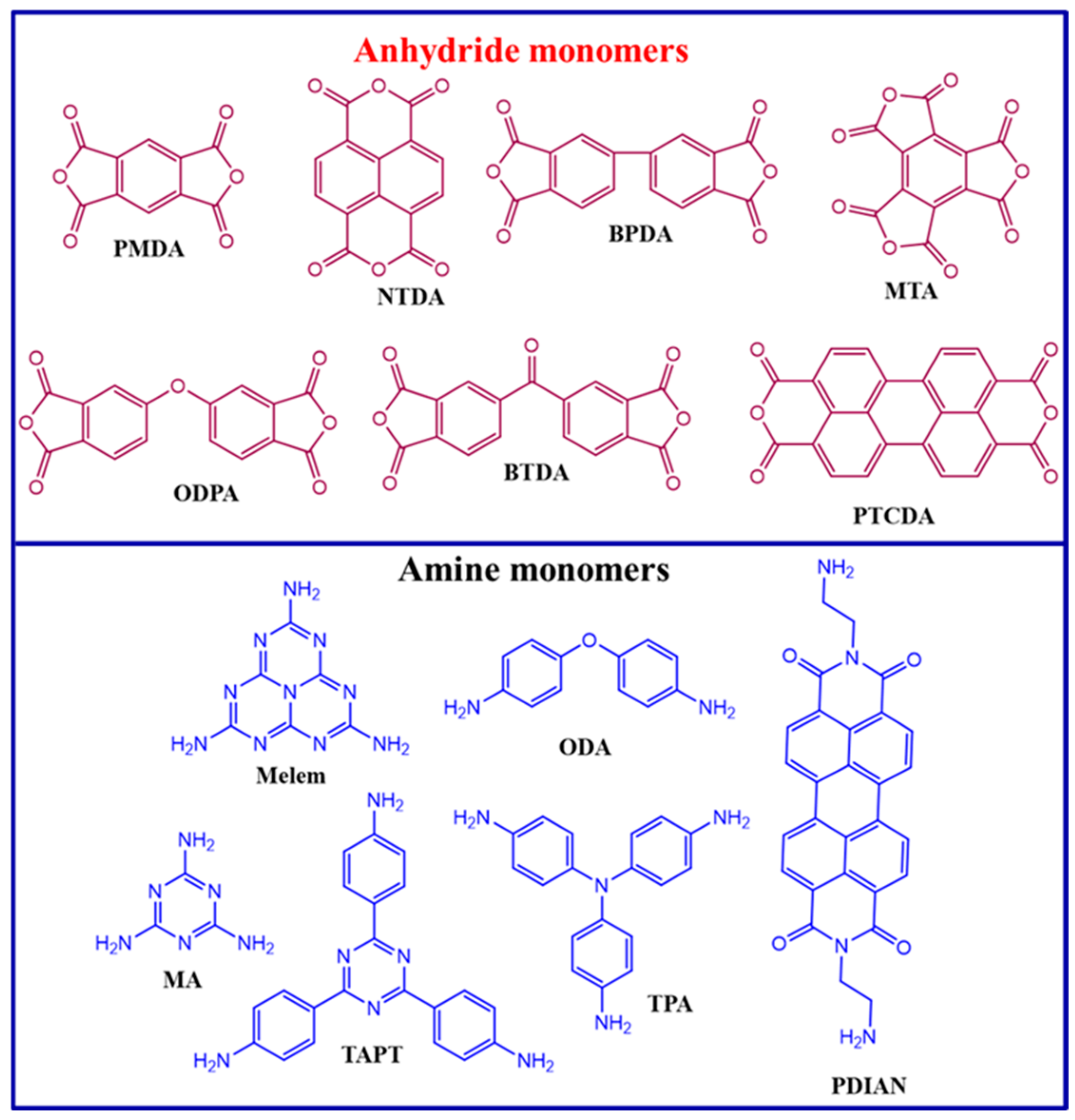

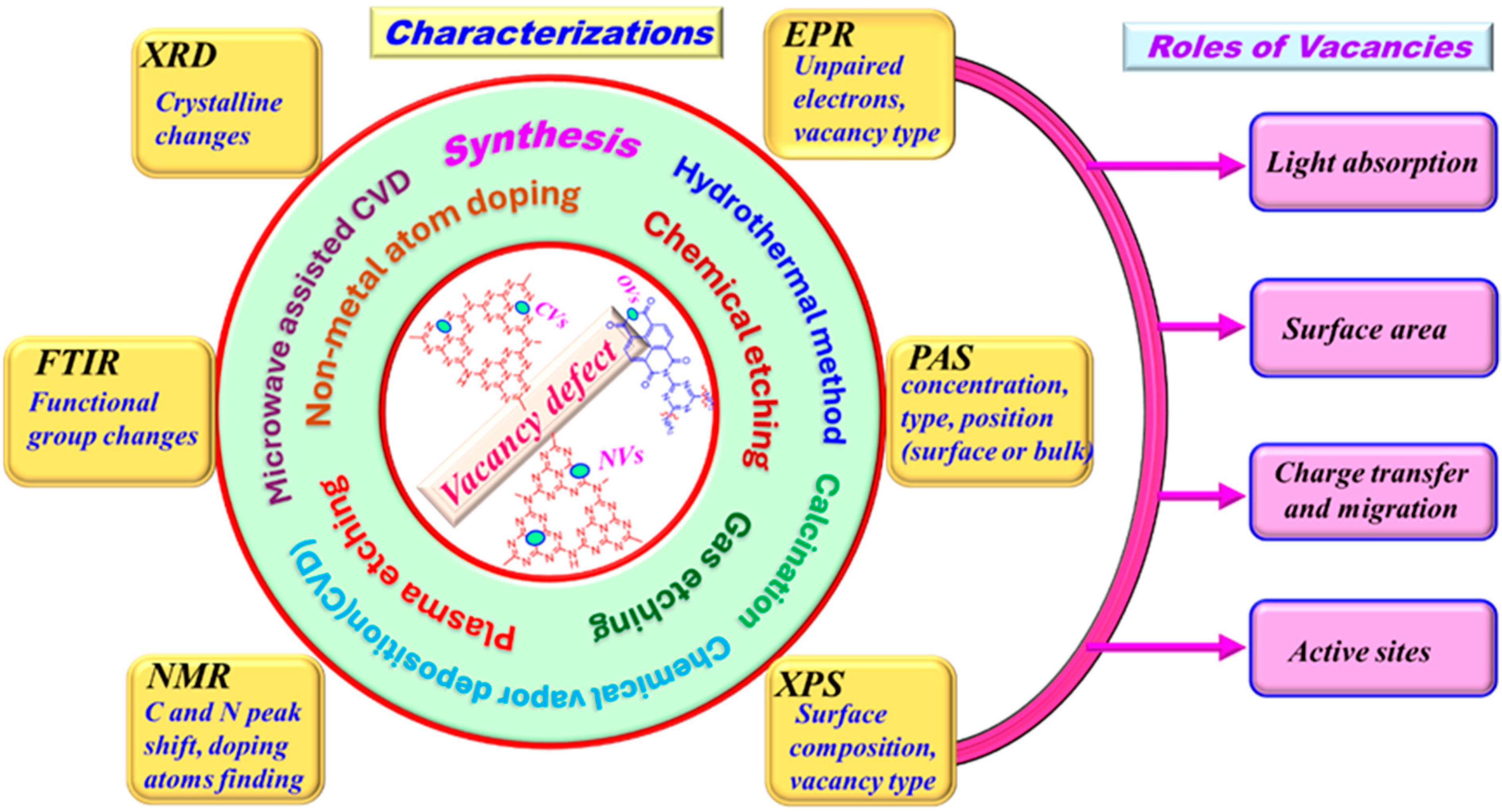



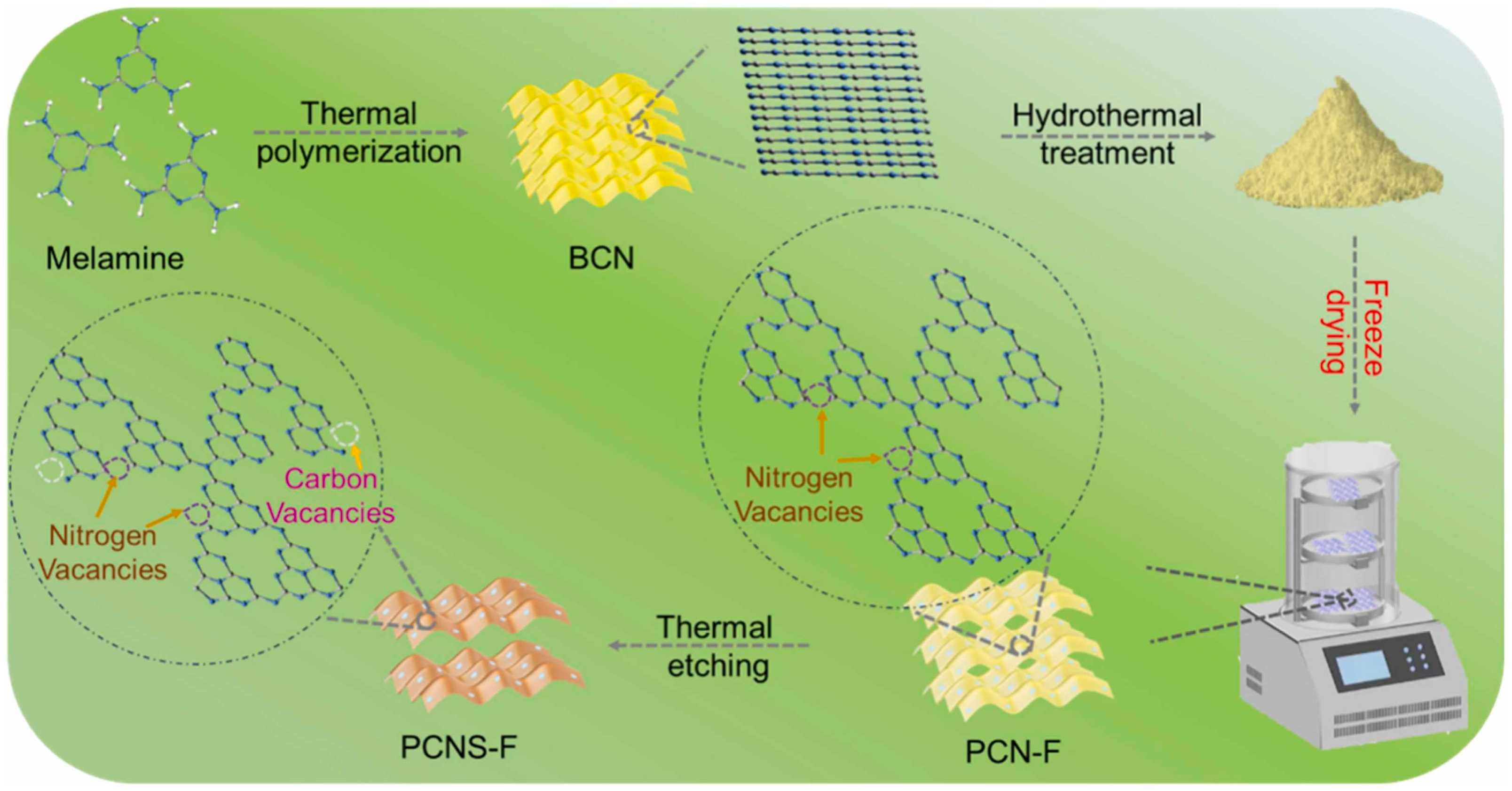


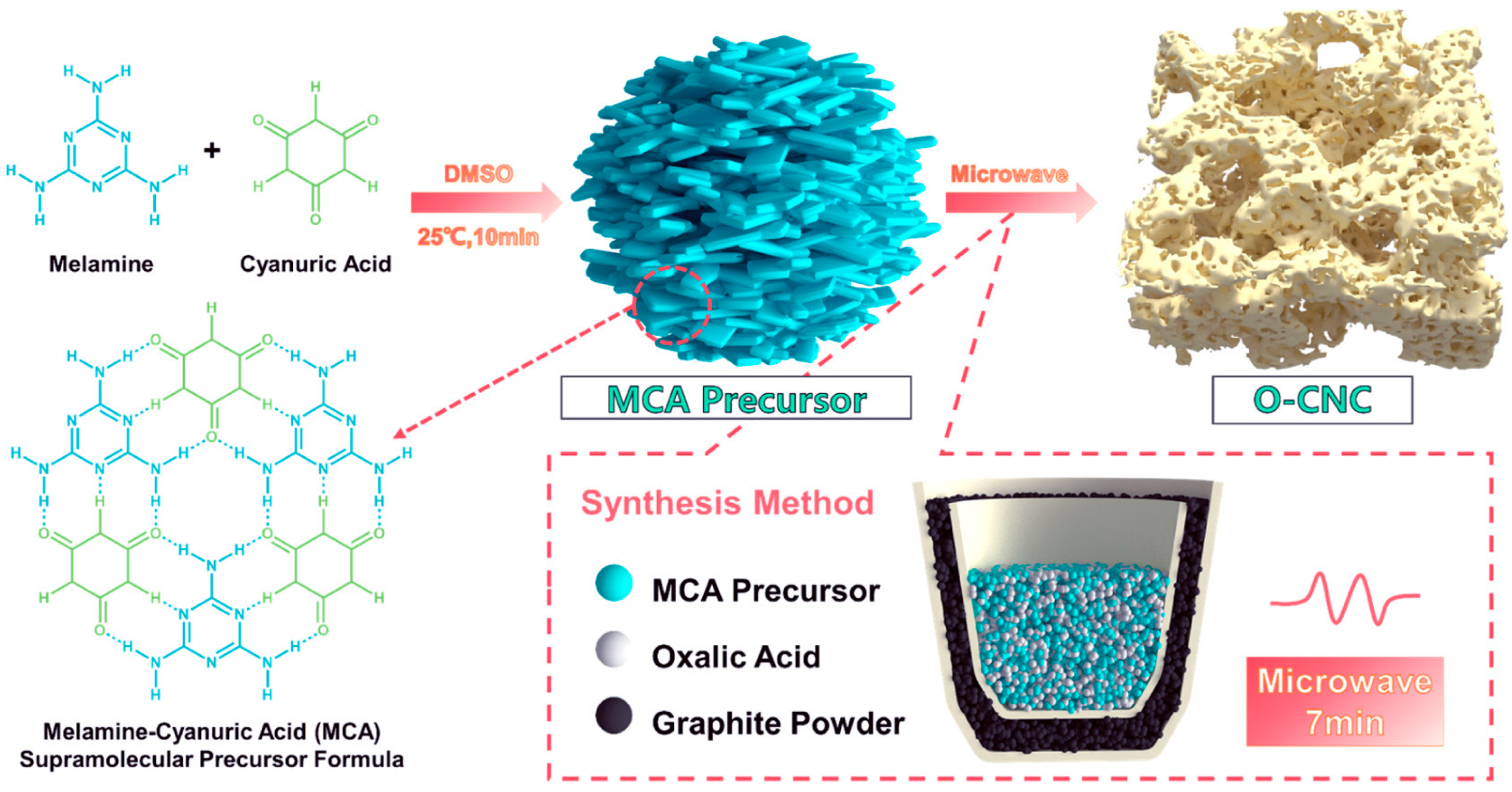
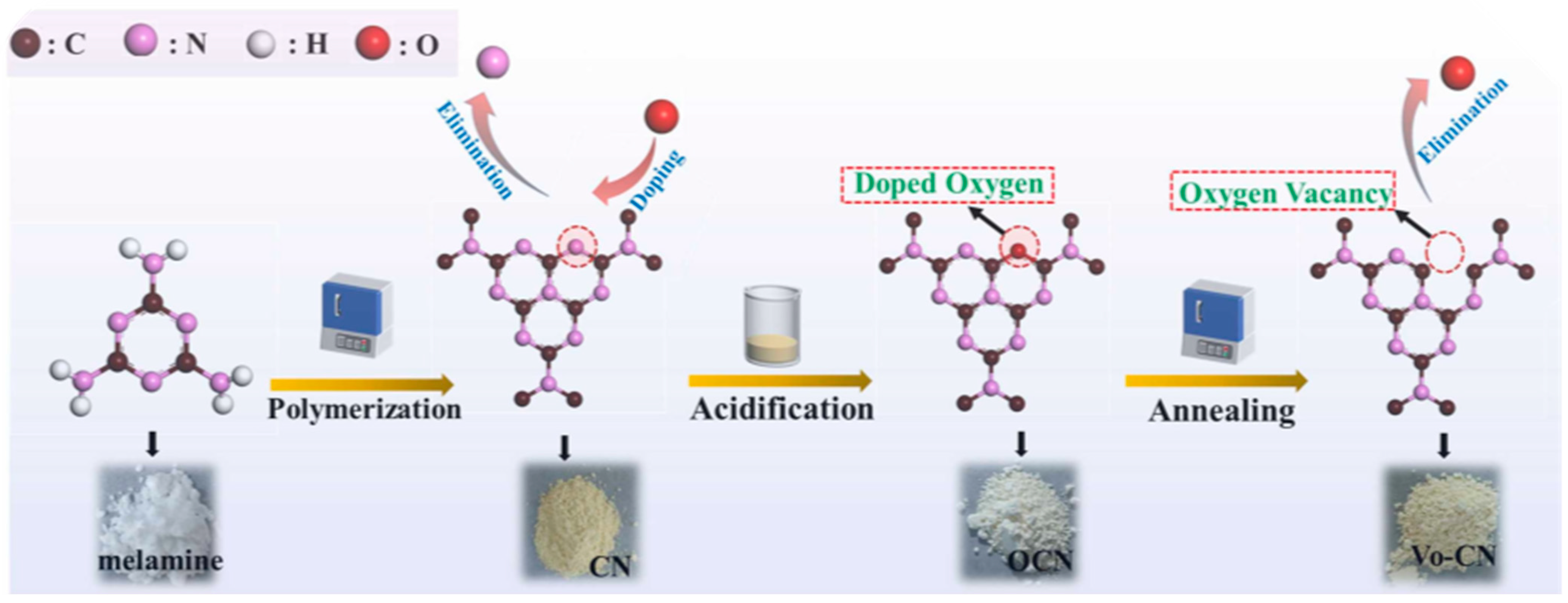
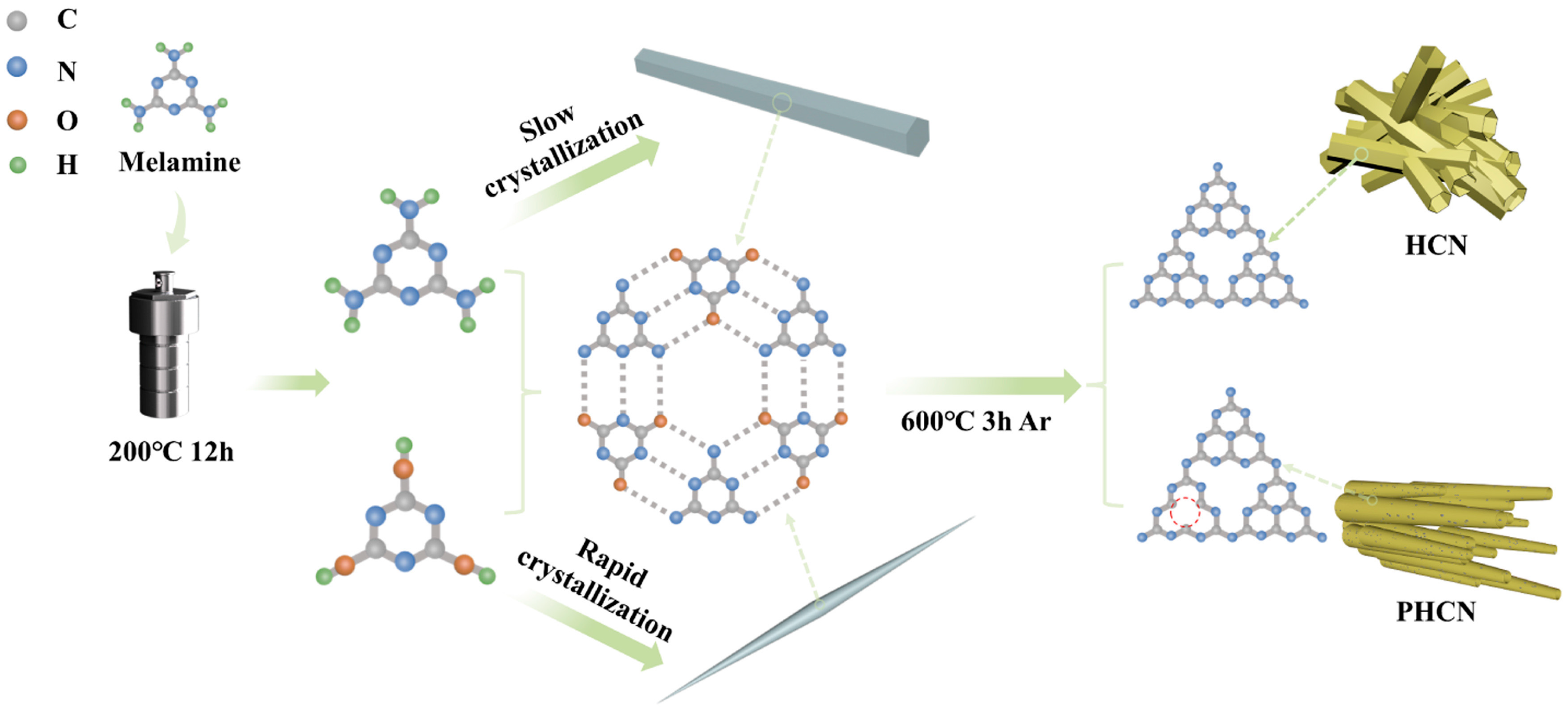



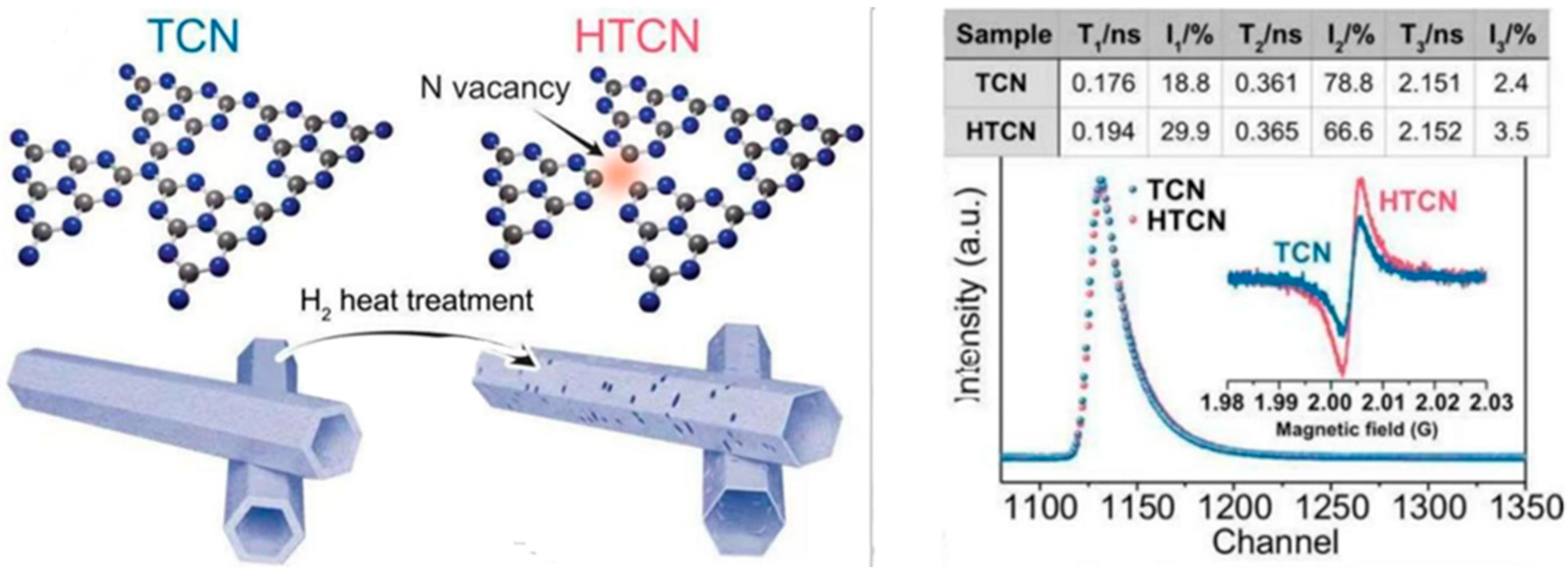
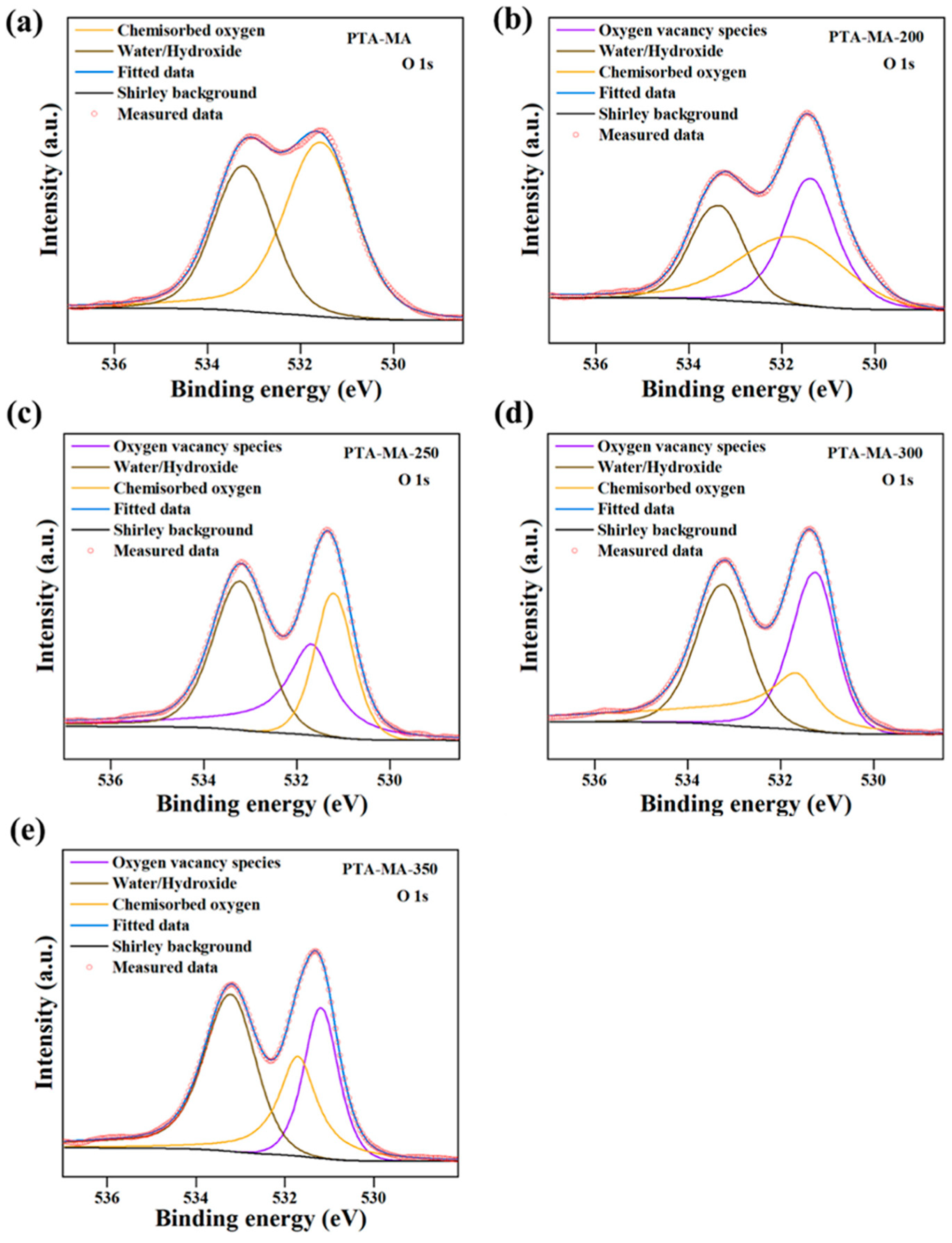
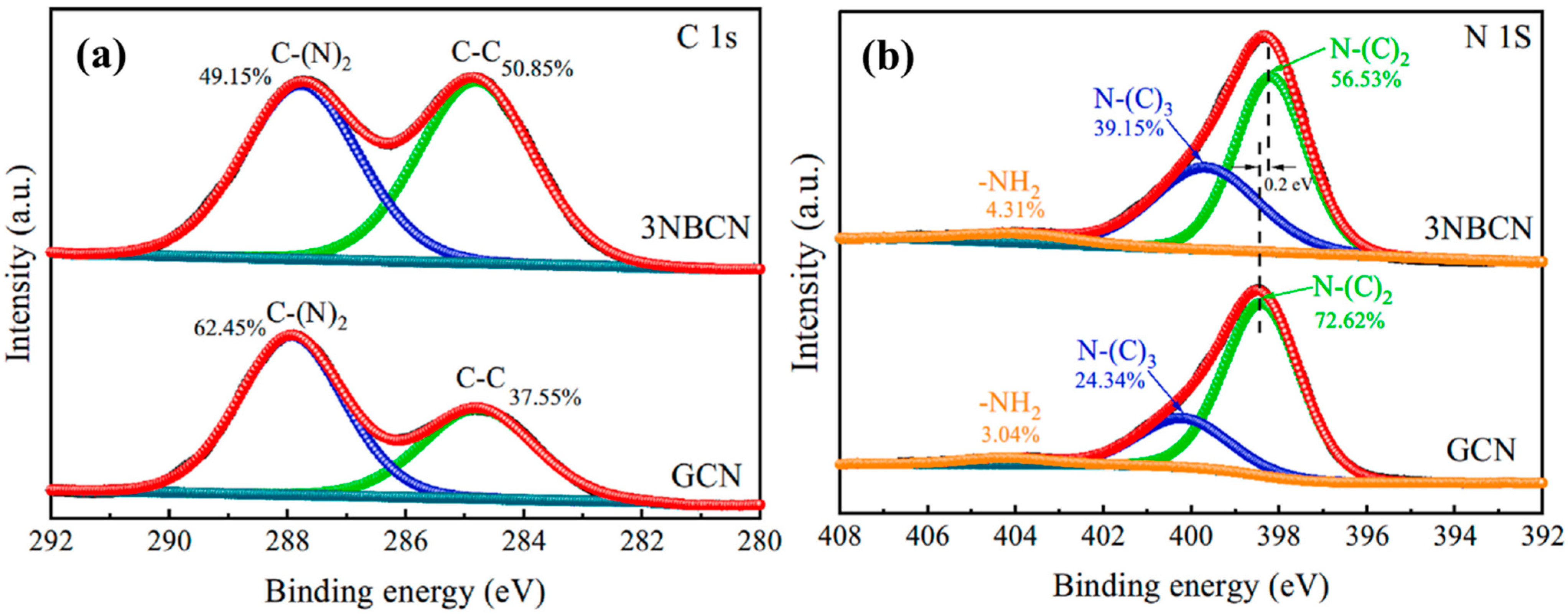
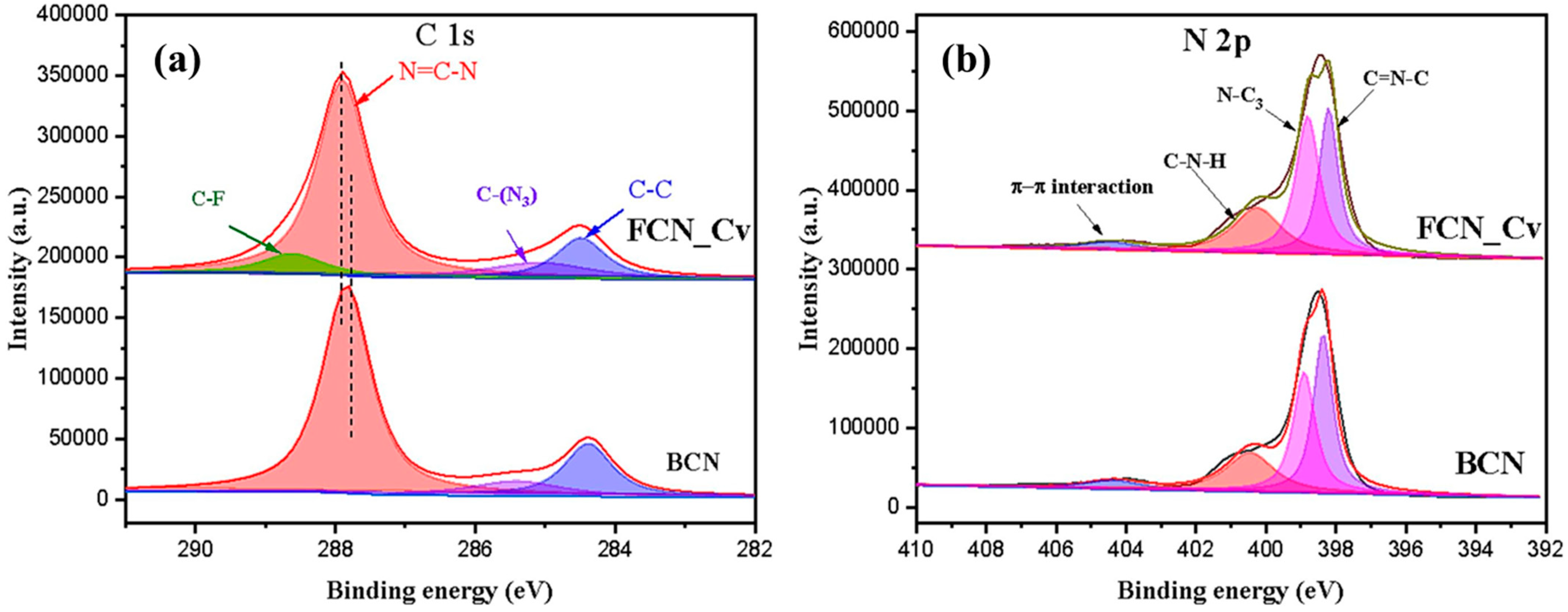
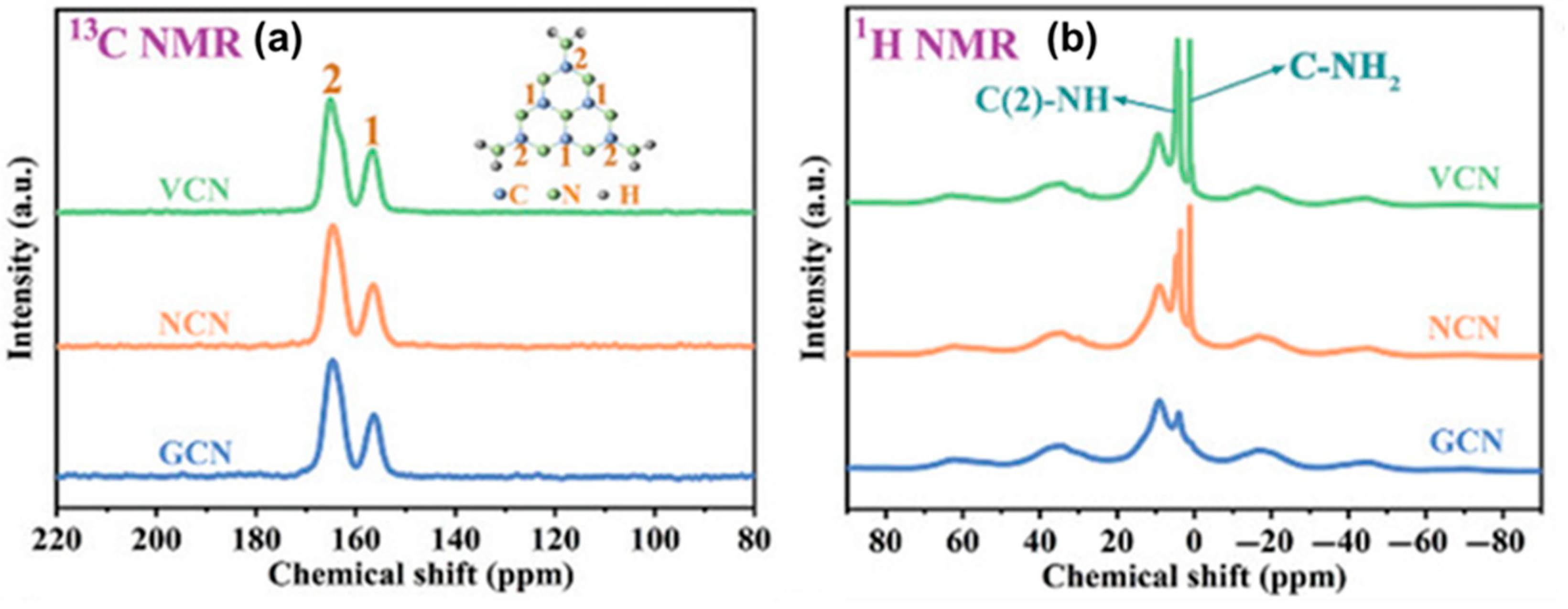
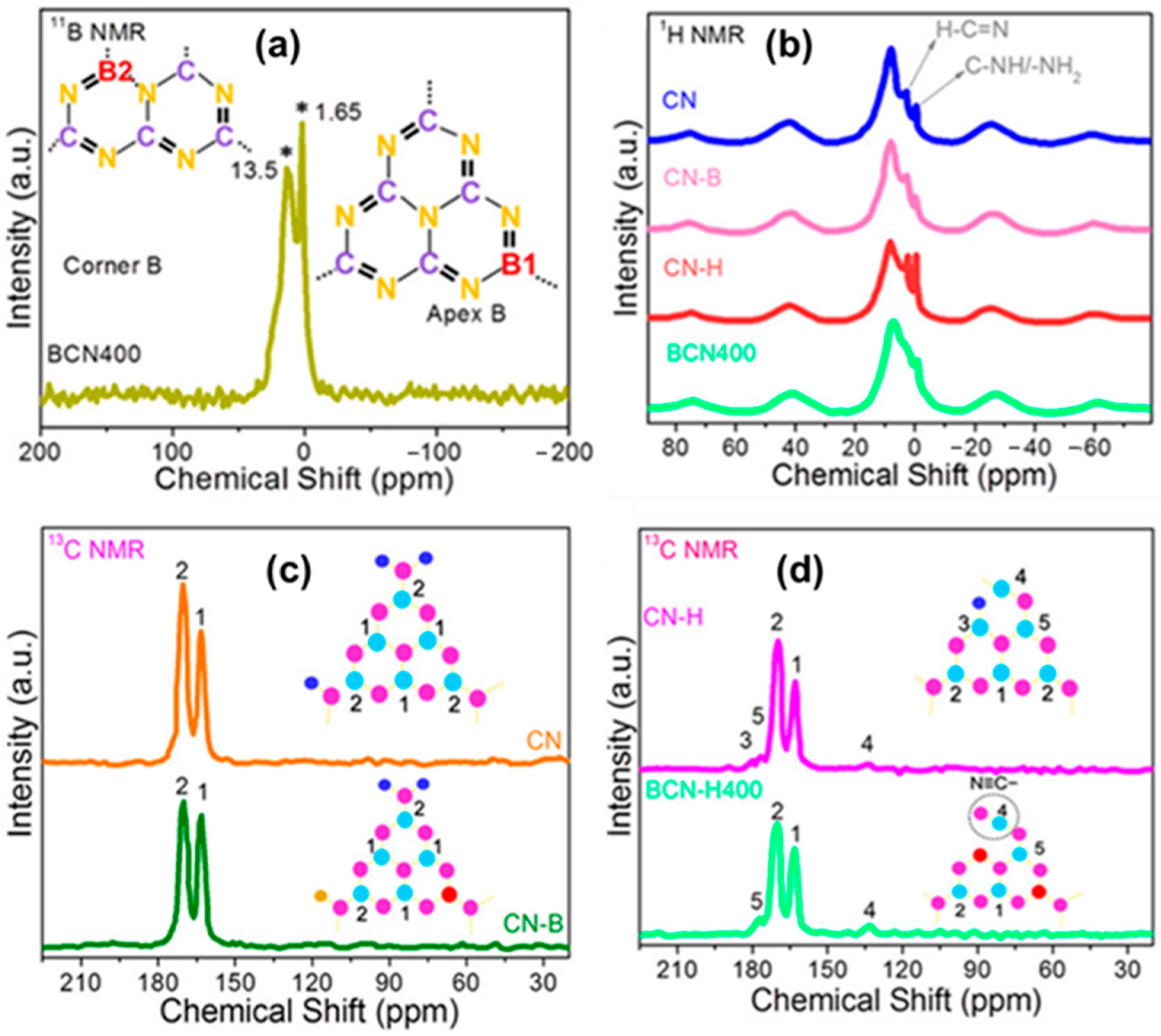
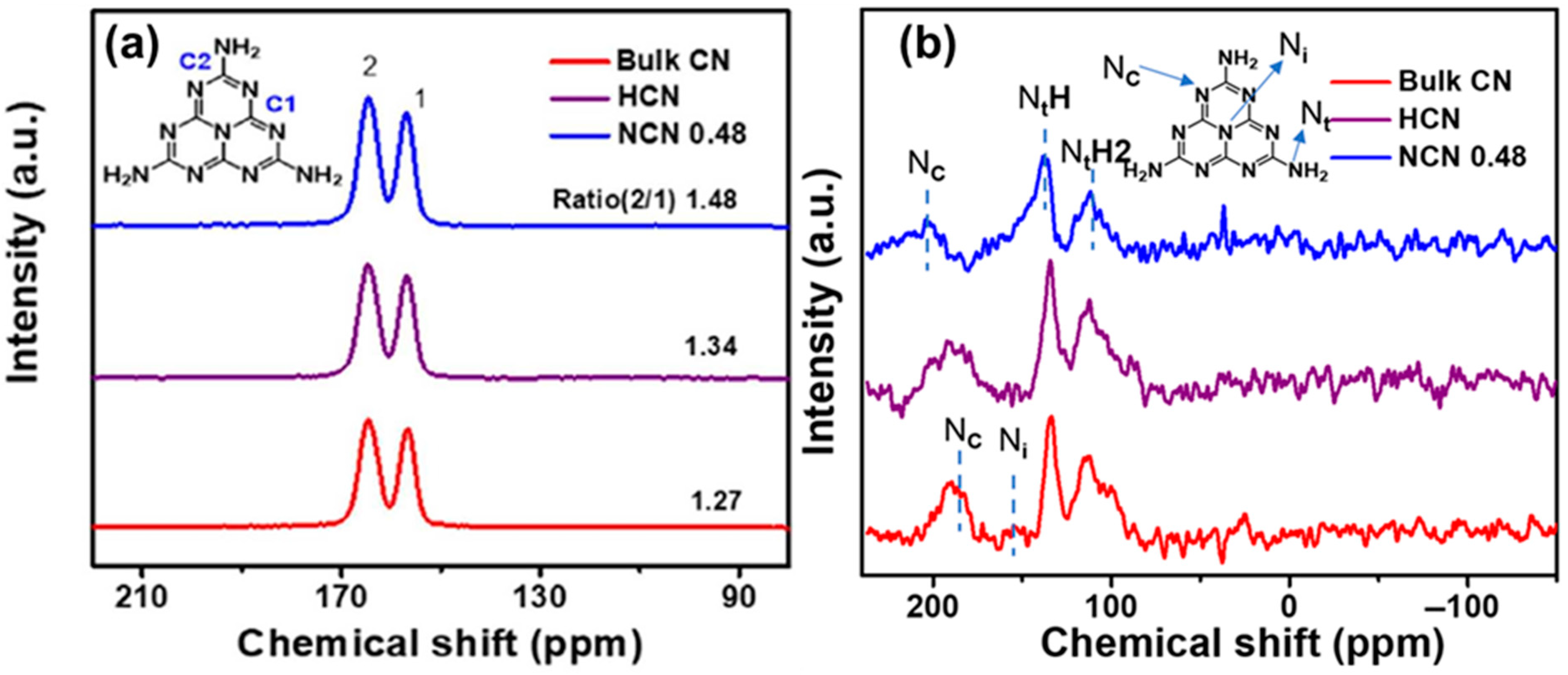
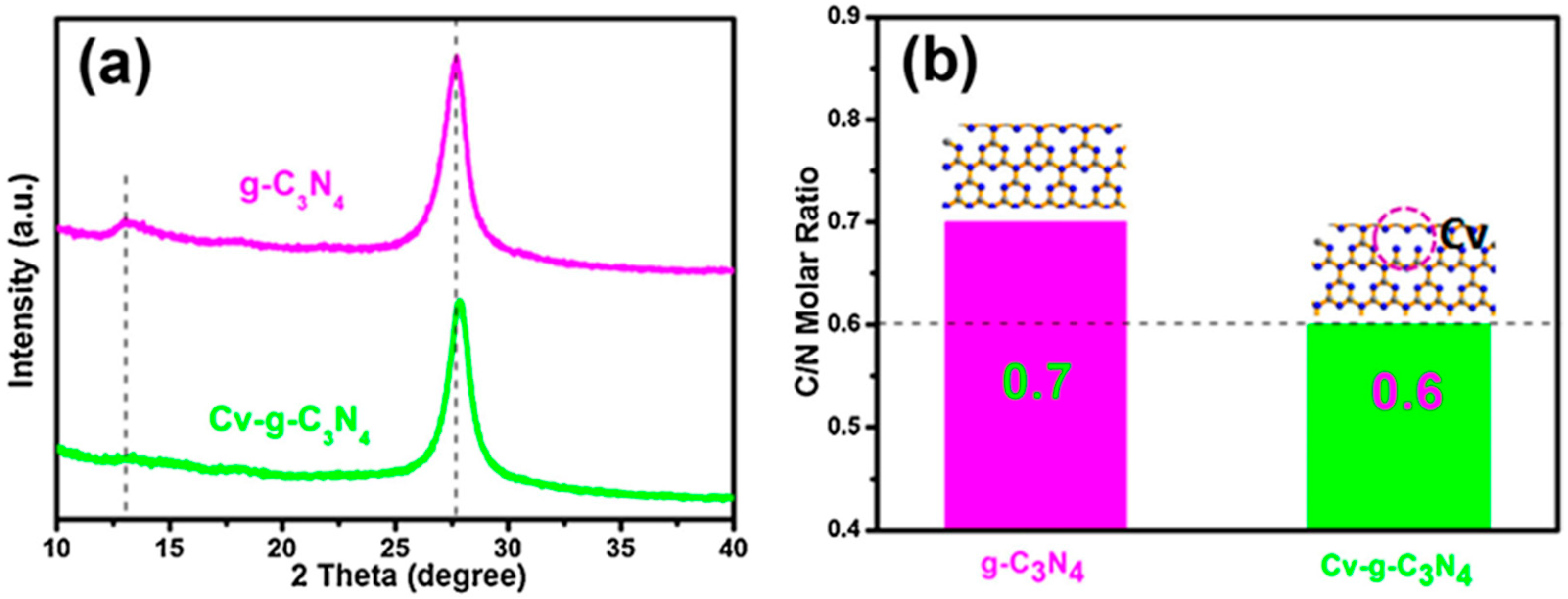


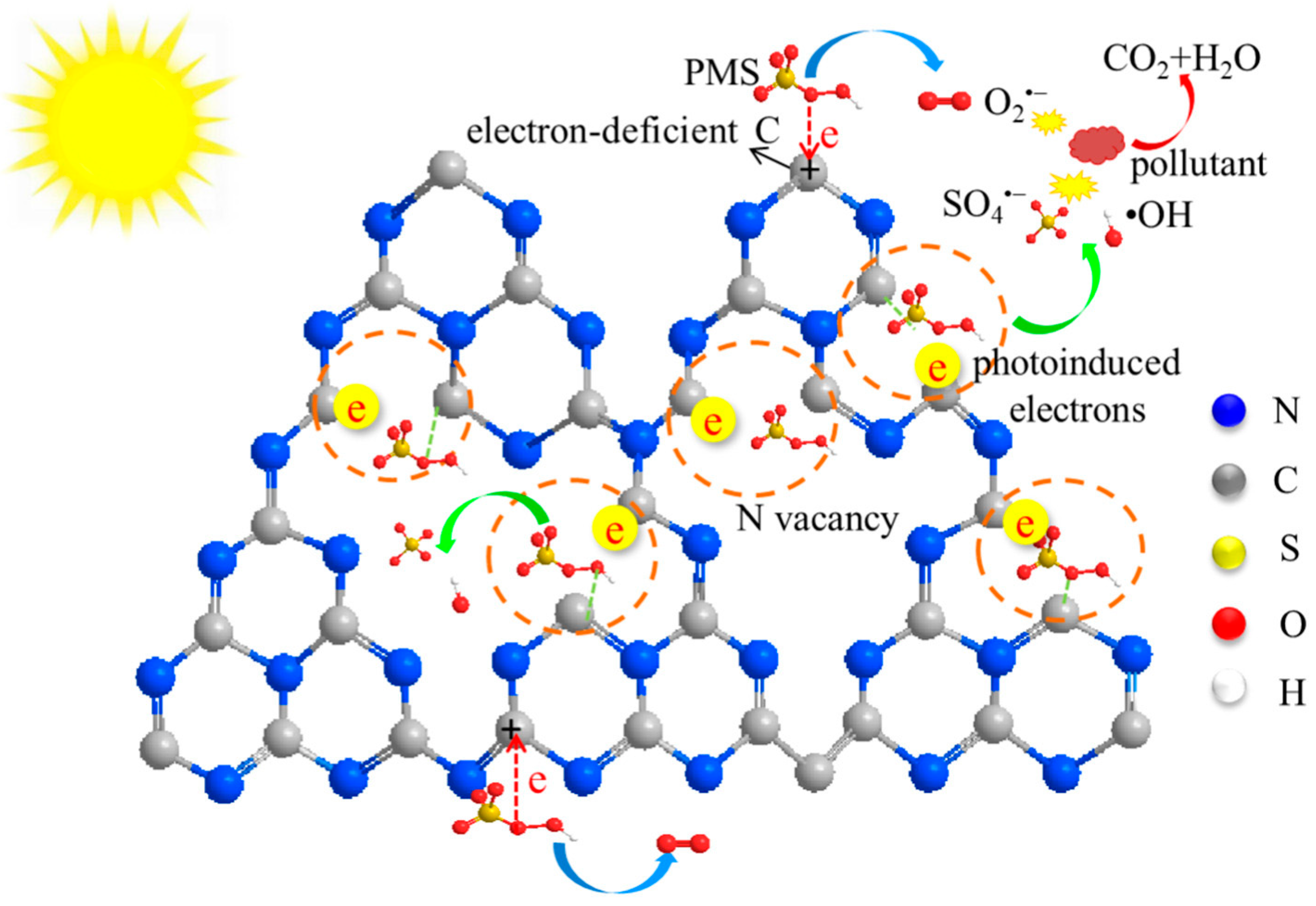
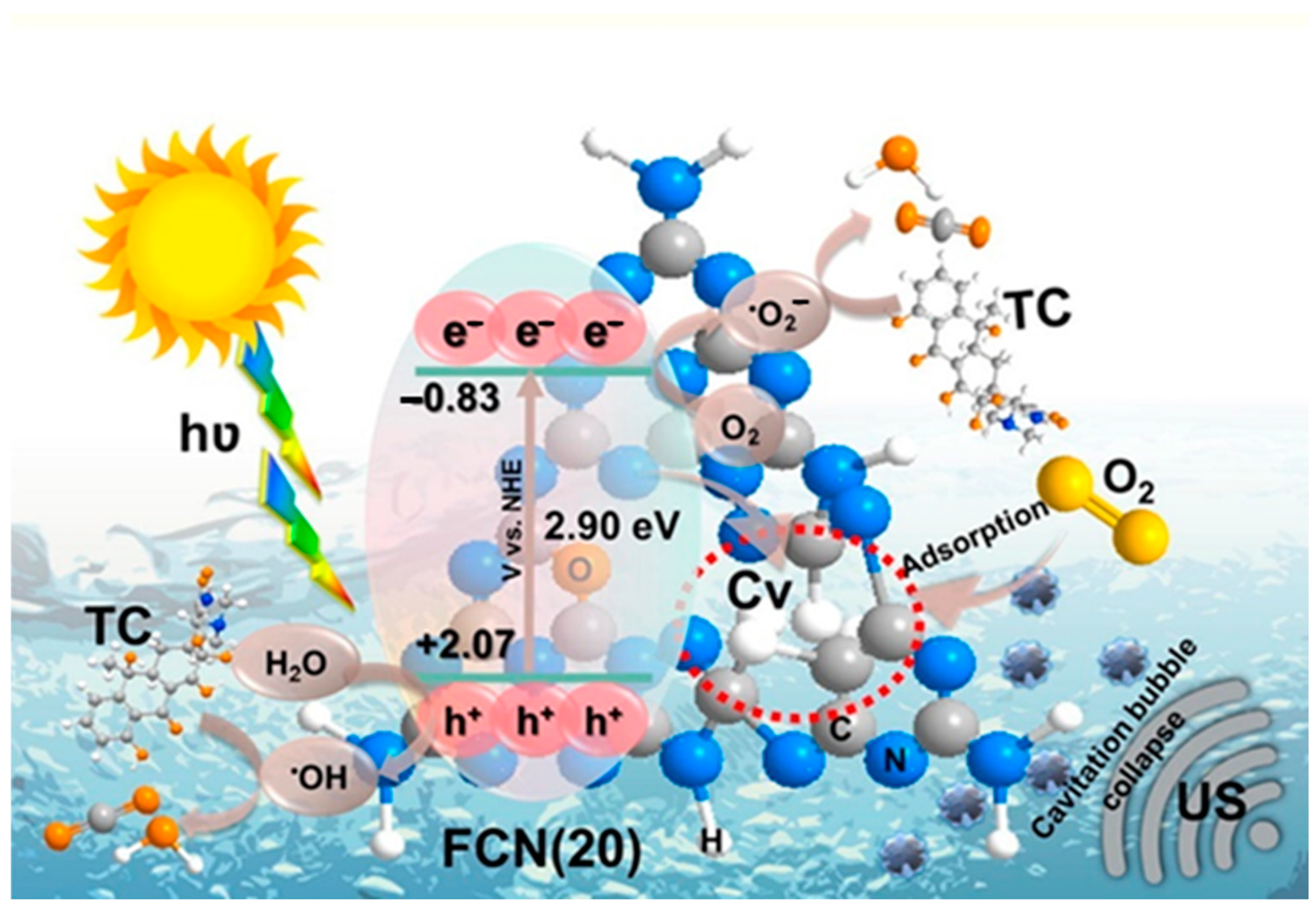
| Method | Advantages | Disadvantages | Reference |
|---|---|---|---|
| Calcination /Thermal polymerization | Scalable, straightforward synthesis, single vacancy creations | Constrained vacancy control and distributions, High temperatures required | [18] |
| Hydrothermal /Solvothermal | Fine-tuning of morphology, Minimal structural disruption | Prolonged reaction time | [55] |
| Chemical vapor deposition (CVD): Microwave-assisted CVD, Muffle furnace-assisted CVD | Easy synthesis, Uniform distribution of vacancies Time-saving | Expensive and challenging to scale for bulk materials | [60,61,62] |
| Non-metal atom doping | Improved stability, multifunctional photocatalyst | Complex synthesis | [63] |
| Chemical etching | High scalability, surface vacancies, | Structural damage, reducing stability | [69] |
| Gas etching | High scalability, most of the vacancies can be created on the surface, Precise vacancy control | Complex synthesis, expensive | [71,72] |
| Plasma treatment | Precise vacancy density control | Complex optimization and expansive | [77,78] |
| Precursors | Method | Vacancy Type | Morphology | Bandgap (eV) | Applications | Efficiency | Ref. |
|---|---|---|---|---|---|---|---|
| Melamine and sulfur | Calcination 550 °C | N vacancies | ultrathin sheet-like | 2.76 | H2 production | 3.16 mmol g−1 h−1 | [110] |
| Melamine | spark plasma sintering 550 °C | N vacancies | nanosheets | 3.07 | H2 production O2 production | 1.51 mmol g−1 h−1 0.75 mmol g−1 h−1 | [88] |
| Melamine and (NH4)2CO3 | calcination 550 °C | C vacancies | lumpy structures | 2.80 | H2 production | 972.3 μmol g−1h−1 | [35] |
| g-C3N4 (glycerol/H2O) | Solvothermal | N vacancies (N3C) | nanosheets | 2.75 | CO2 reduction | 4.18 μmol g−1h−1 (CO) | [55] |
| Bulk g-C3N4 | Hydrothermal followed by calcination at 500 °C | Dual or C and N vacancies | ultra-thin lamellar structure | 2.63 | Degradation of tetracycline and methylene blue | 81.7% 97.7% 120 min | [48] |
| Molten urea | Formalin assisted calcination at 500 °C | C vacancies | sheet-like stacking structures | 2.91 | Degradation of tetracycline | 97%, 60 min | [80] |
| Bulk g-C3N4 | Ar atm, 550 °C | C vacancies | lamellar | 2.78 | H2O2 production metronidazole degradation | 984 μmol L−1h−1 90.7%, 100 min | [32] |
| Bulk g-C3N4 | Etching with NaBH4 | C vacancies | layered stacking | 2.70 | H2 production Cr(VI) reduction | 1764.9 μmol g−1h−1 | [36] |
| Ammonium acetate, urea | Calcination at 550 °C | N vacancies (N3C) | sheet-like structure | 2.39 | N2 fixation H2O2 production | 1915 μmol h−1 g−1 1098 μmol h−1 g−1 | [90] |
| N vacancy g-C3N4 | Hydrothermal at 180 °C | C and N vacancies | lamellar structure | 2.45 | Degradation of tetracycline | ≥99.6%, 3 min | [56] |
| Bulk g-C3N4 | In air, Calcination at 550 °C | C vacancies | wrinkled thin nanosheets | - | Degradation of Direct Red 227/direct Black 166 | 91.5%, 120 min 77.6%, 120 min | [38] |
| g-C3N4 | In N2, Calcination at 550 °C | N vacancies | nano-belt | 2.11 | Degradation of propylparaben | 94.3%, 30 min | [41] |
| Urea and KOH | Calcination at 550 °C | N vacancies | fragmented | 2.46 | H2O2 production | 623.5 μmol g−1h−1 | [91] |
| g-C3N4 | etching Chromic acid solution | N vacancies | thinner nanolayers | 2.79 | H2 production CO2 reduction | 2608 μmol g−1 h−1 15.4 μmol g−1 h−1 | [112] |
| Thin-wall tube g-C3N4 | Calcination at 500 °C under 70 °C Vapor using Ar carrier gas | C vacancies | thin-wall tubes | 2.94 | H2 production | 6588 μmol g−1 h−1 | [73] |
| urea, thiourea, acetamide, Melamine | Calcination at 550 °C | N vacancies | nanosheets | 2.96 | degradation of atrazine (ATZ) | 95.55%, 240 min | [43] |
| bulk g-C3N4 | Calcination at 400 °C | C vacancies | lamellar structure | 2.70 | H2 production | 1.69 mmol·g−1·h−1 | [70] |
| Needle shaped g-C3N4 | Ar atm, Calcination at 600 °C | N vacancies | porous hollow tubes | 2.93 | H2 production Degradation of Tetracycline and RhB | 2028.9 μmol g−1 h−1 79.5%, 10 min 100%, 10 min | [74] |
| Melamine, Urea, thiourea | Calcination (CVD) | S,O co-doped N vacancies | Nanosheets | 2.85 | Degradation of Methyl orange (MO) | ~90%, 30 min | [44] |
| BCN | Hydrothermal etching with NH4F, calcination at 550 °C under Ar | F decorated C vacancies | 2D sheet | 2.99 | ozonation of sodium p-perfluorinated nonoxybenzenesulfonate (OBS) | 99.2%, 30 min | [64] |
| BCN Melamine | Calcination at 520 °C under Ar atm. Melamine-NH4Cl hydrothermal, and Calcination at 550 °C under N2 | C vacancies N vacancies | sheet-like structure sheet-like structure | 2.67 2.69 | H2O2 Production H2O2 Production | 187.9 μmol g−1·h−1 159.0 μmol g−1·h−1 | [2] |
| Melamine, Cyanuric acid and Sulfur | Solvothermal, calcination (200 °C/with sulfur, 550 °C). | N vacancies and S dopants | hollow nanobox | 2.68 | H2 production | 4219.9 µmol g−1 h−1 | [127] |
| Melamine (HCN) | 550 °C (BCN) HCl Hydrothermal (HCN), NaBH4 calcination, N-defect | N vacancies | Nanosheets | 2.27 | H2O2 production | 329.6 μmol h−1g−1 | [128] |
| Melamine | Second calcination 650 °C | N vacancies | disordered pores with corrosion | 1.78 | H2 production | 1102 µmol g−1 h−1 | [129] |
| Thiocyanuric acid | calcination 550 °C | Sulfur doped and C, N vacancies | lamellar and ribbon-like structure | 2.61 | H2 production | 17.70 mmol g−1 h−1 | [130] |
| Melamine, boron solution and NH4Cl | calcination 550 °C | B doped N vacancies | Porous nanosheets | 2.47 | H2 production CO2 reduction | 6959 µmol g−1 h−1 69.1 µmol g−1 h−1 (CO) | [131] |
| Bulk g-C3N4 and Carbon Spheres | Hydrothermal 160 °C | N vacancies | regular spherical | 2.40 | CO2 reduction Cr(VI) reduction | 7.68 μmol g−1h−1 (CO) | [132] |
| Melamine, ammonium iodide | Calcination at 500 °C | I-doped C vacancies | overlapped and stacked | 2.45 | Degradation of tetracycline | 99.8 %, 150 min | [133] |
| Melamine, Cyanuric acid | Ar/H2 gas, Calcination at 500 °C | N vacancies | hollow microtubule | 2.57 | CO2 reduction | 7.06 μmol g−1h−1 (CO) | [134] |
| g-C3N4 | formic acid etching | N vacancies | irregular lamellar structures | 2.74 | H2 production CO2 reduction | 1170 μmol g−1 h−1 3.5 μmol g−1 h−1 (CO) | [135] |
| Melamine and cyanuric acid | Calcination at 520 °C | O-doped N vacancies | hollow nanotubes | 2.83 | H2 production RhB degradation | 421.3 μmol g−1 h−1 | [136] |
| BCN | etching with H3BO3 500 °C under N2 | B-doped N vacancies | Thin nanosheets | 2.70 | Degradation of Tetracycline | 100%, 40 min | [137] |
| BCN | Treating with sodium bisulfite at RT | N vacancies | nanosheets | 2.77 | CO2 reduction Cr(VI) reduction | 5.74 μmol·g−1·h−1 (CO), 1.30 μmol· g−1·h−1 (CH4) | [138] |
Disclaimer/Publisher’s Note: The statements, opinions and data contained in all publications are solely those of the individual author(s) and contributor(s) and not of MDPI and/or the editor(s). MDPI and/or the editor(s) disclaim responsibility for any injury to people or property resulting from any ideas, methods, instructions or products referred to in the content. |
© 2025 by the authors. Licensee MDPI, Basel, Switzerland. This article is an open access article distributed under the terms and conditions of the Creative Commons Attribution (CC BY) license (https://creativecommons.org/licenses/by/4.0/).
Share and Cite
Pundi, A.; Chang, C.-J. Synthesis, Characterization, and Roles of Vacancy Defects in Polymer and Graphitized Carbon Nitride Photocatalysts: A Comprehensive Review. Polymers 2025, 17, 334. https://doi.org/10.3390/polym17030334
Pundi A, Chang C-J. Synthesis, Characterization, and Roles of Vacancy Defects in Polymer and Graphitized Carbon Nitride Photocatalysts: A Comprehensive Review. Polymers. 2025; 17(3):334. https://doi.org/10.3390/polym17030334
Chicago/Turabian StylePundi, Arul, and Chi-Jung Chang. 2025. "Synthesis, Characterization, and Roles of Vacancy Defects in Polymer and Graphitized Carbon Nitride Photocatalysts: A Comprehensive Review" Polymers 17, no. 3: 334. https://doi.org/10.3390/polym17030334
APA StylePundi, A., & Chang, C.-J. (2025). Synthesis, Characterization, and Roles of Vacancy Defects in Polymer and Graphitized Carbon Nitride Photocatalysts: A Comprehensive Review. Polymers, 17(3), 334. https://doi.org/10.3390/polym17030334







